Paul van Yperen's Blog, page 215
November 22, 2019
New acquisitions: Pathé Frères
Between 1903 and 1910, Pathé dominated the international film world. Three-quarter of what every film visitor, even in America, would see in a vaudeville house, in the booth of a travelling cinema, or in one of the very early permanent cinemas, were Pathé productions. The driving force behind this pioneering film operation was Charles Pathé. He set both the artistic and technical standards for film. Pathé Frères also pioneered during the early 1910s with postcards of the actors in its films. Today, a post on postcards by Edition Pathé Frères, Ivo Blom acquired recently. And I added one of my own acquisitions, a few star postcards published for the promotion of the Pathé-Baby, a 9.5 mm projector for home entertainment, which was introduced by Pathé in 1922.
Edition Pathé Frères

French postcard by Edition Pathé Frères. Photo: Henri Manuel.
Yvonne de Bray (1887-1954) was a French stage and screen actress, famous for her role as Sophie in Jean Cocteau's film Les parents terribles (1948).
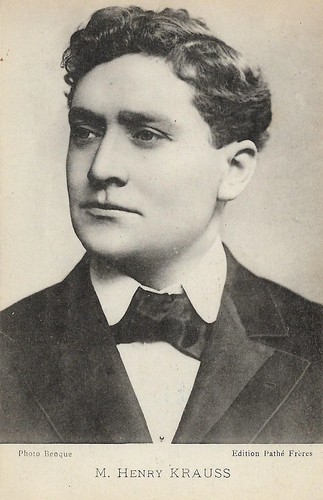
French postcard by Edition Pathé Frères. Photo: Benque.
French actor and director Henry Krauss (1866-1935) was a veteran of the European cinema. From 1908 on he starred in several powerful character roles in early silent films.
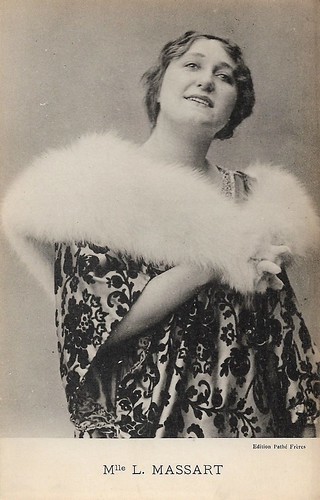
French postcard by Edition Pathé Frères. Photo: X.
Léontine Massart (1885-1980) was a French stage and screen actress of Belgian origin. She peaked in French silent film of the early 1910s.
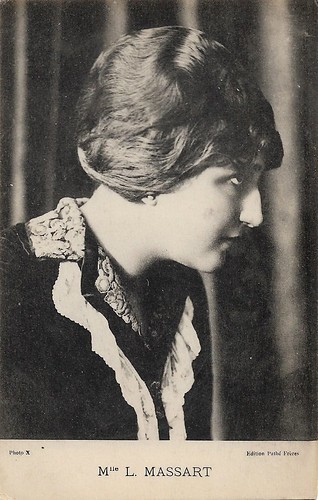
French postcard by Edition Pathé Frères.
Léontine Massart (1885-1980) was a French stage and screen actress of Belgian origin. She peaked in French silent film of the early 1910s.
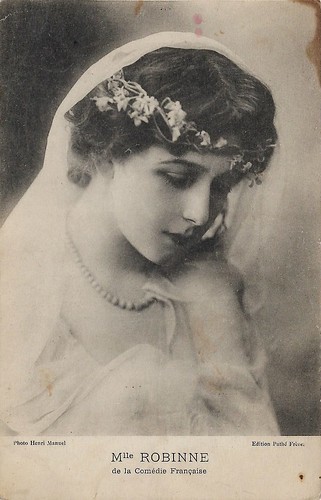
French postcard by Edition Pathé Frères. Photo: Henri Manuel. Mlle Robinne de la Comédie Française.
Gabrielle Robinne (1886-1980) was a French stage and film actress, who had the peak of her film career in the 1910s.
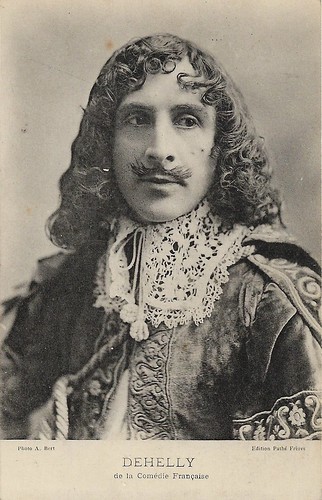
French postcard by Edition Pathé Frères. Photo: A. Bert. Emile Dehelly de la Comédie Française. French actor Emile Dehelly as D'Artagnan in the Le Film d'Art production of Les trois mousquetaires/The Three Musketeers (Henri Pouctal, 1913), based on Alexandre Dumas' famous novel.
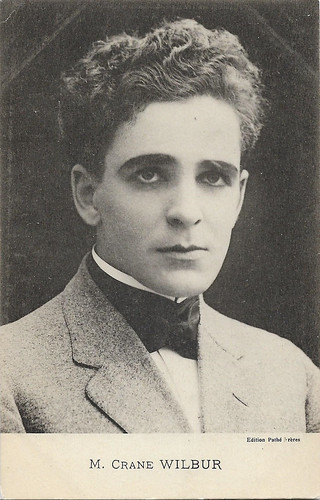
French postcard by Edition Pathé Frères.
Crane Wilbur (1886–1973) was an American writer, actor, and director for stage, radio, and screen, best remembered for playing Harry Marvin in the popular Pathé serial The Perils of Pauline (1914).
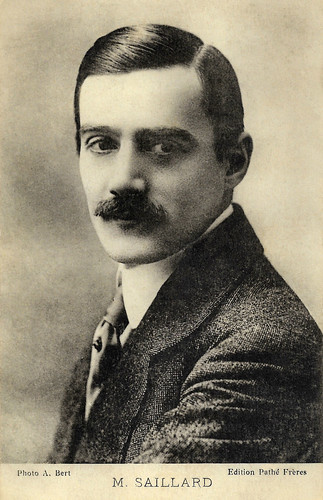
French postcard by Edition Pathé Frères. Photo: A. Bert.
French actor Georges Saillard (1877-1967) appeared from 1909 on in several early silent Eclair and Pathé productions. He was born in 1877 in Besançon, Doubs, France as Georges Augustin Eugène. He was known for his roles in films like Le petit Jacques/Little Jack (Georges Monca, 1913), Les misérables (Henri Fescourt, 1925) starring Gabriel Gabrio, and Yoshiwara (Max Ophüls, 1937), starring Pierre-Richard Willm and Sessue Hayakawa. Saillard died in 1967 in Versailles, Yvelines, France. He had starred in more than 70 films between 1909 and 1950.
Check out this earlier post about Edition Pathé Frères.
Pathé Baby
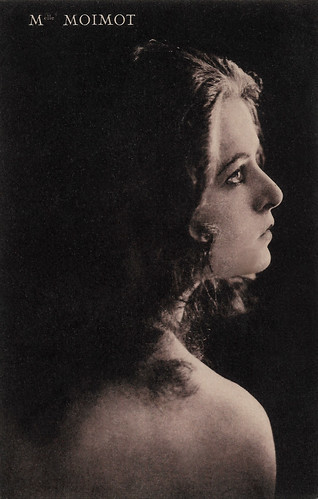
French postcard by Helio Paul et Vigier, Paris, ca. 1922. Photo: Pathé. Promotional postcard for the Pathé-Baby.
Miss (Mademoiselle) Moimotis an unknown actress who probably appeared in Pathé productions. Pathé-Baby was the name given by Charles Pathé to a mainstream amateur cinema system launched in 1922 and using a 9.5 mm wide film with central perforations, the smallest format existing at the time. The Pathé-Baby was initially a small crank projector capable of projecting short films packaged in a metal cartridge that contained less than ten meters of non-flammable film. For Christmas 1922 , several thousand Pathé-Baby projectors were put on the market accompanied by an important catalog of 192 titles extracted from the Pathé film library. Because of the success and demand, a camera was made, also by the company Continsouza, and put on the market in 1923 .
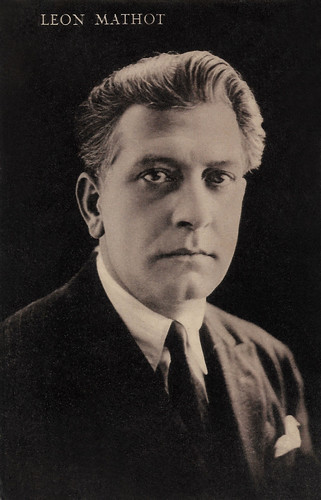
French postcard by Helio Paul et Vigier, Paris, ca. 1922. Photo: Pathé. Promotional postcard for the Pathé-Baby.
Léon Mathot was a French actor and director, born 1886 in Roubaix and died 1968 in Paris. Mathot became well-known for his role of Edmond Dantès in the French serial Le Comte de Monte-Cristo (1918), directed by Henri Pouctal. Mathot became one of the most popular stars of French silent film of the 1920s with such film as L'Empereur des pauvres (René Leprince, 1922) and Coeur fidèle (1923) by Jean Epstein. From 1927, he also became a film director, directing over 20 films.
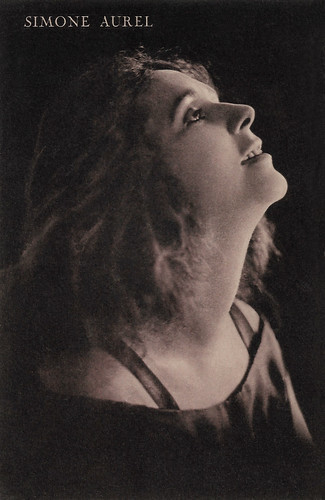
Simone Aurel. French postcard by Helio Paul et Vigier, Paris, ca. 1922. Photo: Pathé. Promotional postcard for the Pathé-Baby.
Edition Pathé Frères

French postcard by Edition Pathé Frères. Photo: Henri Manuel.
Yvonne de Bray (1887-1954) was a French stage and screen actress, famous for her role as Sophie in Jean Cocteau's film Les parents terribles (1948).

French postcard by Edition Pathé Frères. Photo: Benque.
French actor and director Henry Krauss (1866-1935) was a veteran of the European cinema. From 1908 on he starred in several powerful character roles in early silent films.

French postcard by Edition Pathé Frères. Photo: X.
Léontine Massart (1885-1980) was a French stage and screen actress of Belgian origin. She peaked in French silent film of the early 1910s.

French postcard by Edition Pathé Frères.
Léontine Massart (1885-1980) was a French stage and screen actress of Belgian origin. She peaked in French silent film of the early 1910s.

French postcard by Edition Pathé Frères. Photo: Henri Manuel. Mlle Robinne de la Comédie Française.
Gabrielle Robinne (1886-1980) was a French stage and film actress, who had the peak of her film career in the 1910s.

French postcard by Edition Pathé Frères. Photo: A. Bert. Emile Dehelly de la Comédie Française. French actor Emile Dehelly as D'Artagnan in the Le Film d'Art production of Les trois mousquetaires/The Three Musketeers (Henri Pouctal, 1913), based on Alexandre Dumas' famous novel.

French postcard by Edition Pathé Frères.
Crane Wilbur (1886–1973) was an American writer, actor, and director for stage, radio, and screen, best remembered for playing Harry Marvin in the popular Pathé serial The Perils of Pauline (1914).

French postcard by Edition Pathé Frères. Photo: A. Bert.
French actor Georges Saillard (1877-1967) appeared from 1909 on in several early silent Eclair and Pathé productions. He was born in 1877 in Besançon, Doubs, France as Georges Augustin Eugène. He was known for his roles in films like Le petit Jacques/Little Jack (Georges Monca, 1913), Les misérables (Henri Fescourt, 1925) starring Gabriel Gabrio, and Yoshiwara (Max Ophüls, 1937), starring Pierre-Richard Willm and Sessue Hayakawa. Saillard died in 1967 in Versailles, Yvelines, France. He had starred in more than 70 films between 1909 and 1950.
Check out this earlier post about Edition Pathé Frères.
Pathé Baby

French postcard by Helio Paul et Vigier, Paris, ca. 1922. Photo: Pathé. Promotional postcard for the Pathé-Baby.
Miss (Mademoiselle) Moimotis an unknown actress who probably appeared in Pathé productions. Pathé-Baby was the name given by Charles Pathé to a mainstream amateur cinema system launched in 1922 and using a 9.5 mm wide film with central perforations, the smallest format existing at the time. The Pathé-Baby was initially a small crank projector capable of projecting short films packaged in a metal cartridge that contained less than ten meters of non-flammable film. For Christmas 1922 , several thousand Pathé-Baby projectors were put on the market accompanied by an important catalog of 192 titles extracted from the Pathé film library. Because of the success and demand, a camera was made, also by the company Continsouza, and put on the market in 1923 .

French postcard by Helio Paul et Vigier, Paris, ca. 1922. Photo: Pathé. Promotional postcard for the Pathé-Baby.
Léon Mathot was a French actor and director, born 1886 in Roubaix and died 1968 in Paris. Mathot became well-known for his role of Edmond Dantès in the French serial Le Comte de Monte-Cristo (1918), directed by Henri Pouctal. Mathot became one of the most popular stars of French silent film of the 1920s with such film as L'Empereur des pauvres (René Leprince, 1922) and Coeur fidèle (1923) by Jean Epstein. From 1927, he also became a film director, directing over 20 films.

Simone Aurel. French postcard by Helio Paul et Vigier, Paris, ca. 1922. Photo: Pathé. Promotional postcard for the Pathé-Baby.
Published on November 22, 2019 22:00
November 21, 2019
Alan Ladd
Alan Ladd (1913-1964) had his big break as a killer in the film noir This Gun For Hire (1942). Throughout the 1940s, his tough-guy roles packed audiences, but he is best known for his title role in the classic Western Shane (1953).
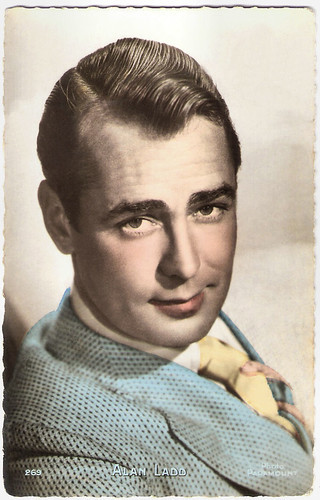
French postcard by Editions P.I., no. 269. Photo: Paramount, 1950.
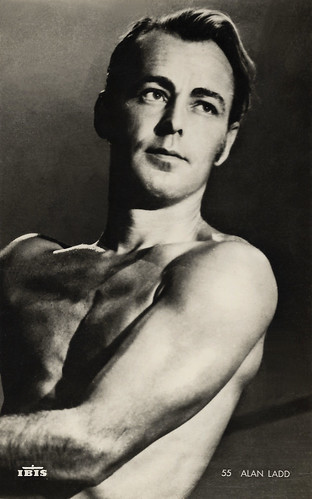
Vintage postcard by IBIS, no. 55. Publicity still for Two Years Before the Mast (John Farrow, 1946).
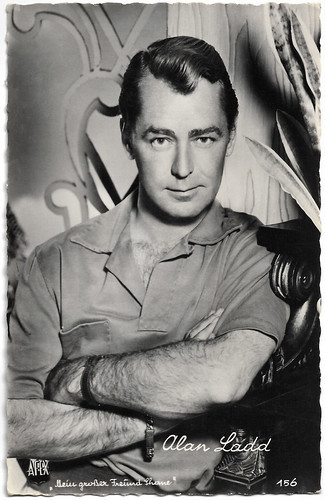
Austrian postcard by Verlag Hubmann (HDH Verlag), Wien, no. 156. Photo: Afex. Photo: Alan Ladd in Shane (George Stevens, 1953).
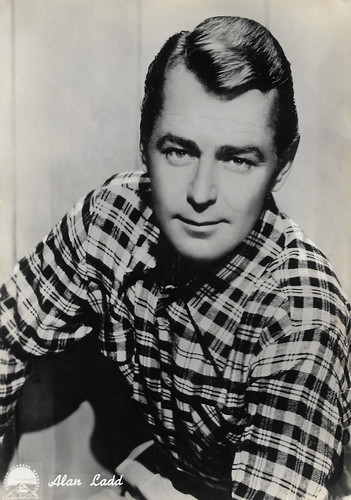
Italian postcard by Bromofoto, Milano, no. 289. Photo: Paramount.
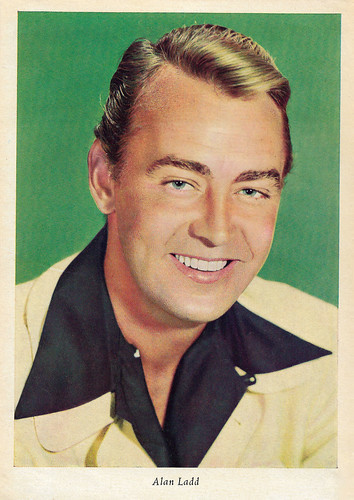
German postcard by Wilhelm Schulze-Witteborg, Grafischer Betrieb, Wanne-Eickel. Photo: Paramount.
Psychotic hitman with a conscience
Alan Walbridge Ladd was born in Hot Springs, Arkansas, USA in 1913. His mother, Ina Raleigh (also known as Selina Rowley), had emigrated from England at age 19, and his accountant father, Alan Ladd, died when his son was only four.
At age five, Alan burned his apartment playing with matches, and his mother moved them to Oklahoma City, where she married Jim Beavers, a housepainter. Alan was malnourished, undersized and nicknamed 'Tiny', and an economic downturn led to Ladd's family moving to California. Alan picked fruit, delivered papers, and swept stores.
In high school he discovered track and swimming. By 1931 he was training for the 1932 Olympics, but an injury put an end to those plans. His diving skills led to his appearance in an aquatic show, 'Marinella' in July 1933. He also worked as a studio carpenter (as did his stepfather) at FBO.
Ladd's performance in his high school show of 'The Mikado' was seen by a talent scout. In August 1933 Ladd was one of a group of young 'discoveries' signed to a long-term contract with Universal Pictures. The contract had options which could go for seven years, but they were all in the studio's favor. Ladd appeared unbilled in a film, Once in a Lifetime (1933), but the studio eventually decided Ladd was too blond and too short and dropped him after six months.
He opened a hamburger stand called Tiny's Patio, but it was not a success. In another attempt to break into the film industry, Ladd went to work at Warner Bros. as a grip, and ended up staying two years. He was injured falling off a scaffold and decided to quit.
Alan married his friend Marjorie Jane 'Midge' Harrold in 1936, but couldn't afford her, so they lived apart. In 1937, they shared a friend's apartment. They had a son, Alan Ladd Jr., and his destitute alcoholic mother moved in with them, following the breakup of a relationship. A few months later, she asked Ladd for some money to buy something at a local store. Ladd gave her the money, thinking it was for alcohol. She purchased some arsenic-based ant paste from a grocer and committed suicide by drinking it in the back seat of Ladd's car.
Ladd worked hard at radio. Ladd's rich, deep voice was ideal for that medium and in 1936 he ended up being signed by station KFWB as its sole radio actor. He stayed for three years at KFWB, working as many as twenty shows a week.
There talent scout and former actress Sue Carol discovered him early in 1939. She enthusiastically promoted her new handsome client in films as well as radio. Ladd's first notable part under Carol's management was the film Rulers of the Sea (Frank Lloyd, 1939), starring Douglas Fairbanks Jr. and Margaret Lockwood . Ladd played a character named 'Colin Farrell' at $250 a week. He also received attention for a small part in Hitler – Beast of Berlin (Sam Newfield, 1939), one of the most popular 'hiss and boo' films of the World War II era.
He appeared in a string of bit parts in B-pictures - and an unbilled part as a newspaper reporter in Orson Welles ' classic Citizen Kane (1941). Ladd's career gained extra momentum when he was cast in a featured role in a wartime drama made at RKO, Joan of Paris (Robert Stevenson, 1942) with Michèle Morgan . It was only a small part but it involved a touching death scene which brought him attention within the industry.
Late in 1941, he got his big break when he tested for This Gun for Hire (Frank Tuttle, 1942) based on the novel by Graham Greene. Director Frank Tuttle was struggling to find a new actor to play the role of 'Raven', a psychotic hitman with a conscience. Ladd's ausition was successful and Paramount signed him to a long-term contract. His fourth-billed role as psychotic hitman Raven made him a star.
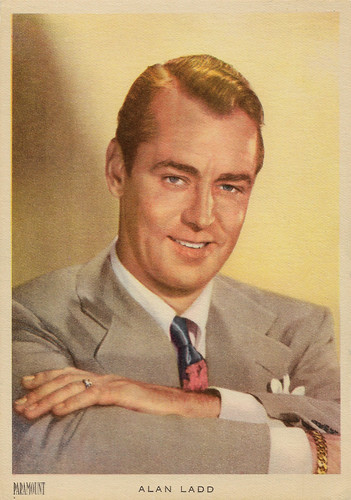
Uruguayan postcard by CF. Photo: Paramount.
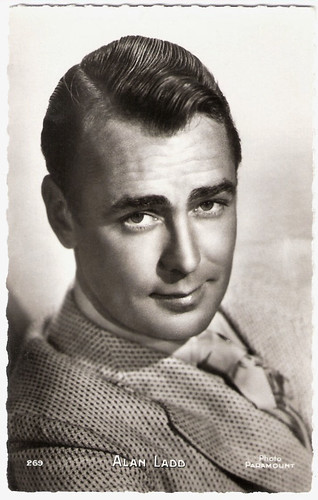
French postcard by Editions P.I., Paris, no. 269, 1950. Photo: Paramount Pictures Inc.
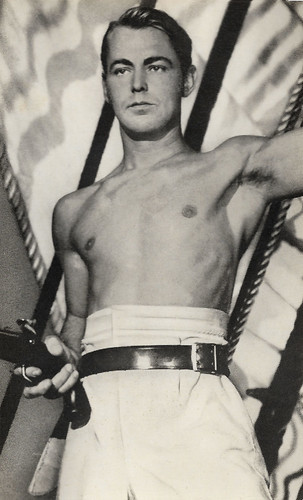
Spanish postcard by JOCABA, no. 3569. Photo: Paramount. Publicity still for Two Years Before the Mast (John Farrow, 1946).
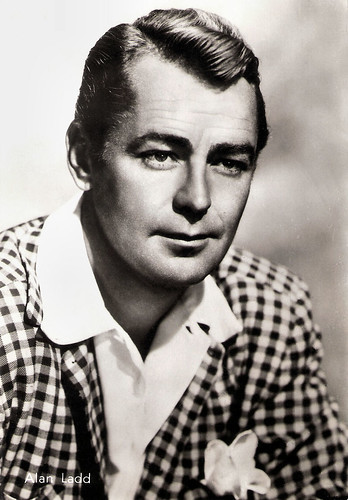
Italian postcard by Bromostampa, Milano, no. 82.
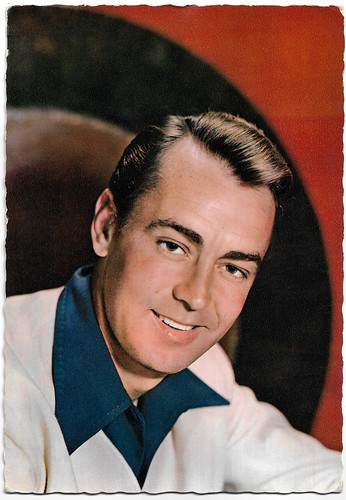
French postcard, no. 109.
Cool, unsmiling tough-guys
Alan Ladd and his co-star in This Gun for Hire, Veronica Lake, then made The Glass Key (Stuart Heisler, 1942). The adaptation of Dashiell Hammett's story was another hit. The New York Times reported that Alan Ladd "in the brief period of a year and with only four starring pictures to his credit... had built up a following unmatched in film history since Rudolph Valentino skyrocketed to fame."
Ladd was drafted in January 1943 and discharged in November with an ulcer and double hernia. He went on to star in films. His cool, unsmiling tough-guys proved popular with wartime audiences, and Alan Ladd became one of the top box office stars of the decade.
With Veronica Lake, he made seven films together. These included the Film Noir The Blue Dahlia (George Marshall 1946), and Saigon (Leslie Fenton, 1948). Then he made his first Western since he became a star and first film in colour, Whispering Smith (Leslie Fenton, 1948). In an adaptation of Scott Fitzgerald's The Great Gatsby (Elliott Nugent, 1949), Ladd had the featured role of Jay Gatsby.
Four years later he appeared in what many regard as his greatest role, Shane (George Stevens, 1953) opposite Jean Arthur and Van Heflin. The film was nominated for five Academy Awards, including Best Picture. It led to Ladd being voted one of the ten most popular stars in the country in 1953.
From then on he was performing in lucrative but unrewarding films. By the end of the 1950s liquor and a string of so-so films had taken their toll. In November 1962 he was found unconscious lying in a pool of blood with a bullet wound near his heart. At the time, Ladd said he thought he heard a prowler, grabbed a gun, and tripped over, accidentally shooting himself. This was accepted by the police investigating.
In 1963 Ladd's career looked set to make a comeback when he filmed a supporting role in The Carpetbaggers (Edward Dmytryk, 1964) with Carroll Baker , which became one of the most popular films of the year. He would not live to see its release.
In January 1964, Alan Ladd was found dead, apparently due to an accidental combination of alcohol and sedatives. Ladd was only 50. He was married twice. After his divorce from Marjorie Jane Harrold in 1941, he married former film actress Sue Carol in 1942, who was also his agent and manager. The couple had two children, actors Alana Ladd and David Ladd. He was the grandfather of actress Jordan Ladd. His first son, Alan Ladd, Jr., is a film executive and producer and founder of the Ladd Company. David Ladd, who co-starred with his father as a child in The Proud Rebel, was married to Charlie's Angels star Cheryl Ladd (née Stoppelmoor), from 1973 till 1980.
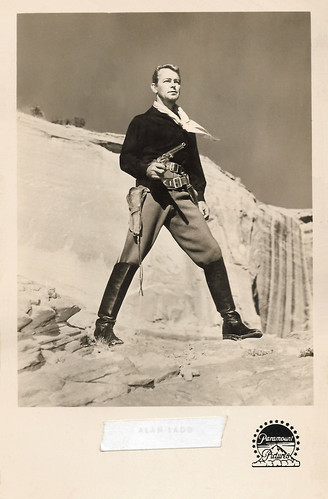
German postcard by Kunst und Bild, Berlin, no. A 372. Photo: Paramount Pictures. Photo: Alan Ladd in Red Mountain (William Dieterle, 1952).
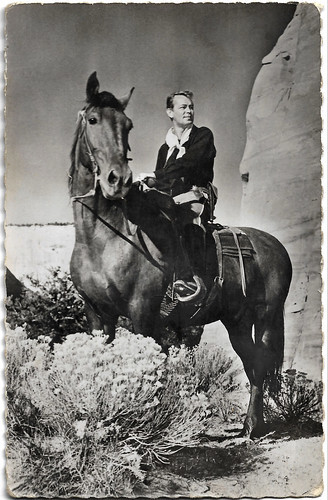
French postcard in the Collection 'Western' by Editions P.I., Paris, no. 40. Photo: Paramount Pictures Inc., 1954. Alan Ladd in Red Mountain (William Dieterle, 1952).
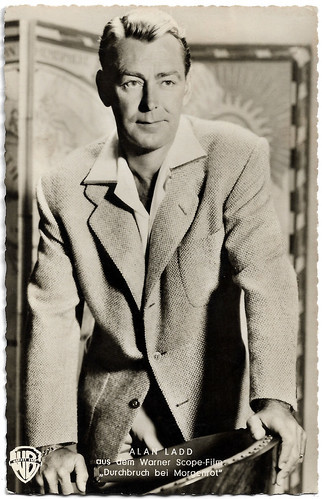
German postcard by Kunst und Bild, Berlin-Charlottenburg, no. T 879. Photo: Warner Bros. Photo: Alan Ladd in The Deep Six (Rudolph Maté, 1958).
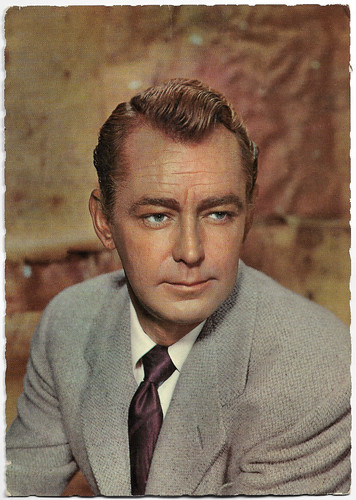
French postcard by E.D.U.G., no. 97.
Sources: (IMDb), Wikipedia and .

French postcard by Editions P.I., no. 269. Photo: Paramount, 1950.

Vintage postcard by IBIS, no. 55. Publicity still for Two Years Before the Mast (John Farrow, 1946).

Austrian postcard by Verlag Hubmann (HDH Verlag), Wien, no. 156. Photo: Afex. Photo: Alan Ladd in Shane (George Stevens, 1953).

Italian postcard by Bromofoto, Milano, no. 289. Photo: Paramount.

German postcard by Wilhelm Schulze-Witteborg, Grafischer Betrieb, Wanne-Eickel. Photo: Paramount.
Psychotic hitman with a conscience
Alan Walbridge Ladd was born in Hot Springs, Arkansas, USA in 1913. His mother, Ina Raleigh (also known as Selina Rowley), had emigrated from England at age 19, and his accountant father, Alan Ladd, died when his son was only four.
At age five, Alan burned his apartment playing with matches, and his mother moved them to Oklahoma City, where she married Jim Beavers, a housepainter. Alan was malnourished, undersized and nicknamed 'Tiny', and an economic downturn led to Ladd's family moving to California. Alan picked fruit, delivered papers, and swept stores.
In high school he discovered track and swimming. By 1931 he was training for the 1932 Olympics, but an injury put an end to those plans. His diving skills led to his appearance in an aquatic show, 'Marinella' in July 1933. He also worked as a studio carpenter (as did his stepfather) at FBO.
Ladd's performance in his high school show of 'The Mikado' was seen by a talent scout. In August 1933 Ladd was one of a group of young 'discoveries' signed to a long-term contract with Universal Pictures. The contract had options which could go for seven years, but they were all in the studio's favor. Ladd appeared unbilled in a film, Once in a Lifetime (1933), but the studio eventually decided Ladd was too blond and too short and dropped him after six months.
He opened a hamburger stand called Tiny's Patio, but it was not a success. In another attempt to break into the film industry, Ladd went to work at Warner Bros. as a grip, and ended up staying two years. He was injured falling off a scaffold and decided to quit.
Alan married his friend Marjorie Jane 'Midge' Harrold in 1936, but couldn't afford her, so they lived apart. In 1937, they shared a friend's apartment. They had a son, Alan Ladd Jr., and his destitute alcoholic mother moved in with them, following the breakup of a relationship. A few months later, she asked Ladd for some money to buy something at a local store. Ladd gave her the money, thinking it was for alcohol. She purchased some arsenic-based ant paste from a grocer and committed suicide by drinking it in the back seat of Ladd's car.
Ladd worked hard at radio. Ladd's rich, deep voice was ideal for that medium and in 1936 he ended up being signed by station KFWB as its sole radio actor. He stayed for three years at KFWB, working as many as twenty shows a week.
There talent scout and former actress Sue Carol discovered him early in 1939. She enthusiastically promoted her new handsome client in films as well as radio. Ladd's first notable part under Carol's management was the film Rulers of the Sea (Frank Lloyd, 1939), starring Douglas Fairbanks Jr. and Margaret Lockwood . Ladd played a character named 'Colin Farrell' at $250 a week. He also received attention for a small part in Hitler – Beast of Berlin (Sam Newfield, 1939), one of the most popular 'hiss and boo' films of the World War II era.
He appeared in a string of bit parts in B-pictures - and an unbilled part as a newspaper reporter in Orson Welles ' classic Citizen Kane (1941). Ladd's career gained extra momentum when he was cast in a featured role in a wartime drama made at RKO, Joan of Paris (Robert Stevenson, 1942) with Michèle Morgan . It was only a small part but it involved a touching death scene which brought him attention within the industry.
Late in 1941, he got his big break when he tested for This Gun for Hire (Frank Tuttle, 1942) based on the novel by Graham Greene. Director Frank Tuttle was struggling to find a new actor to play the role of 'Raven', a psychotic hitman with a conscience. Ladd's ausition was successful and Paramount signed him to a long-term contract. His fourth-billed role as psychotic hitman Raven made him a star.

Uruguayan postcard by CF. Photo: Paramount.

French postcard by Editions P.I., Paris, no. 269, 1950. Photo: Paramount Pictures Inc.

Spanish postcard by JOCABA, no. 3569. Photo: Paramount. Publicity still for Two Years Before the Mast (John Farrow, 1946).

Italian postcard by Bromostampa, Milano, no. 82.

French postcard, no. 109.
Cool, unsmiling tough-guys
Alan Ladd and his co-star in This Gun for Hire, Veronica Lake, then made The Glass Key (Stuart Heisler, 1942). The adaptation of Dashiell Hammett's story was another hit. The New York Times reported that Alan Ladd "in the brief period of a year and with only four starring pictures to his credit... had built up a following unmatched in film history since Rudolph Valentino skyrocketed to fame."
Ladd was drafted in January 1943 and discharged in November with an ulcer and double hernia. He went on to star in films. His cool, unsmiling tough-guys proved popular with wartime audiences, and Alan Ladd became one of the top box office stars of the decade.
With Veronica Lake, he made seven films together. These included the Film Noir The Blue Dahlia (George Marshall 1946), and Saigon (Leslie Fenton, 1948). Then he made his first Western since he became a star and first film in colour, Whispering Smith (Leslie Fenton, 1948). In an adaptation of Scott Fitzgerald's The Great Gatsby (Elliott Nugent, 1949), Ladd had the featured role of Jay Gatsby.
Four years later he appeared in what many regard as his greatest role, Shane (George Stevens, 1953) opposite Jean Arthur and Van Heflin. The film was nominated for five Academy Awards, including Best Picture. It led to Ladd being voted one of the ten most popular stars in the country in 1953.
From then on he was performing in lucrative but unrewarding films. By the end of the 1950s liquor and a string of so-so films had taken their toll. In November 1962 he was found unconscious lying in a pool of blood with a bullet wound near his heart. At the time, Ladd said he thought he heard a prowler, grabbed a gun, and tripped over, accidentally shooting himself. This was accepted by the police investigating.
In 1963 Ladd's career looked set to make a comeback when he filmed a supporting role in The Carpetbaggers (Edward Dmytryk, 1964) with Carroll Baker , which became one of the most popular films of the year. He would not live to see its release.
In January 1964, Alan Ladd was found dead, apparently due to an accidental combination of alcohol and sedatives. Ladd was only 50. He was married twice. After his divorce from Marjorie Jane Harrold in 1941, he married former film actress Sue Carol in 1942, who was also his agent and manager. The couple had two children, actors Alana Ladd and David Ladd. He was the grandfather of actress Jordan Ladd. His first son, Alan Ladd, Jr., is a film executive and producer and founder of the Ladd Company. David Ladd, who co-starred with his father as a child in The Proud Rebel, was married to Charlie's Angels star Cheryl Ladd (née Stoppelmoor), from 1973 till 1980.

German postcard by Kunst und Bild, Berlin, no. A 372. Photo: Paramount Pictures. Photo: Alan Ladd in Red Mountain (William Dieterle, 1952).

French postcard in the Collection 'Western' by Editions P.I., Paris, no. 40. Photo: Paramount Pictures Inc., 1954. Alan Ladd in Red Mountain (William Dieterle, 1952).

German postcard by Kunst und Bild, Berlin-Charlottenburg, no. T 879. Photo: Warner Bros. Photo: Alan Ladd in The Deep Six (Rudolph Maté, 1958).

French postcard by E.D.U.G., no. 97.
Sources: (IMDb), Wikipedia and .
Published on November 21, 2019 22:00
November 20, 2019
Evelyn Cron
German actress Evelyn Cron (1940) was one of the stars of the DEFA in the 1960s. She appeared in more than 30 films and TV productions. In 1985 she left the GDR.

East-German card by VEB Progress Film-Vertrieb, no. 2.605, 1966. Photo: DEWAG / Bundermann.
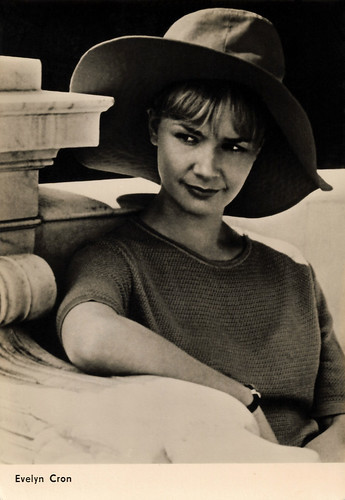
East-German card by VEB Progress Film-Vertrieb, no. 1.989, 1964. Photo: DEFA / Blümel.
Catwalk Model
Eevlyn Cron was born in 1940 in Magdeburg, Germany.
Already at school Cron played theatre. She learned the profession of a dental nurse. In her free time, she worked as a catwalk model for the Magdeburg fashion house Bormann.
At such an event, she was discovered by the DEFA, which was looking for an actress for the title role in the musical comedy Die schöne Lurette/The Beautiful Lurette (Gottfried Kolditz, 1960) with Jirí Papez and Otto Mellies .
After test shots she received the role of Lurette and a trainee contract with the German television, where she was trained from 1961 to 1963 to become an actress.
She made her stage debut as a guest in Jacques Deval's 'Stormy Crossing at Spiegelglatter See' at the Kammerspiele Leipzig. It was followed by engagements in Magdeburg and Berlin.
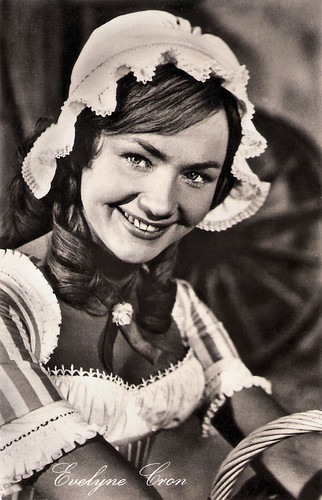
East-German card by VEB Progress Film-Vertrieb, no. 1364, 1960. Photo: DEFA / Schneider. Evelyn Cron in Die schöne Lurette/The Beautiful Lurette (Gottfried Kolditz, 1960).
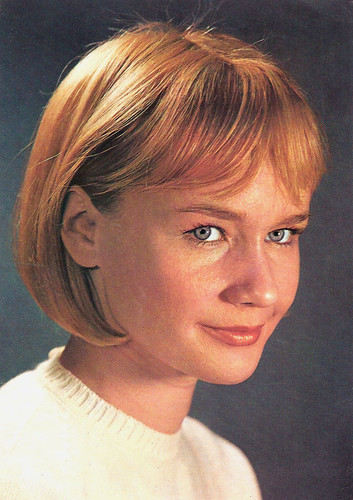
East-German card by VEB Progress Film-Vertrieb, no. 2394, 1965. Photo: Schwarzer.
Departing the GDR
Evelyn Cron also became known for such films as the fairytale Die goldene Jurte/The golden yurt (Rawsha Dorshpalam, Gottfried Kolditz, 1961) - a coproduction with Mongolia.
Later followed the gangster comedy Hände hoch oder ich schieße/Hands Up or I'll Shoot (Hans-Joachim Kasprzik, 1966) with Rolf Herricht, which was forbidden by the GDR government. It had finally its premiere in 2009.
Evelyn Cron also appeared in the tragicomedy Der nackte Mann auf dem Sportplatz/The Naked Man in the Stadium (Konrad Wolf, 1974) featuring Kurt Böwe. Her last feature film was Jadup und Boel/Jadup and Boel (Rainer Simon, 1980), also with Kurt Böwe.
Furthermore, she was a permanent member in the actor ensemble of the East-German television and played in productions of the Moritzburg Television Theater such as Noel Coward's Ghost Comedy (1966), Curt Goetz' The Fairy Tale (1966), Eugène Scribes The Money Marriage (1970) and Paul Herbert Freyer's Brocade from France (1972).
Evelyn Cron departed the GDR in 1985. From 1988 to 1993 she had a permanent engagement at the Tribune in Berlin.
She continues to appear regularly on the German television. In 2014, she appeared in an episode of the Krimi series SOKO Wismar. SOKO is an abbreviation of the term 'Sonderkommission' (Special Commission - meaning special investigation team of the police in German). She also played in the TV comedy Das Gewinnerlos/The winner lot (Patrick Winczewski, 2015).
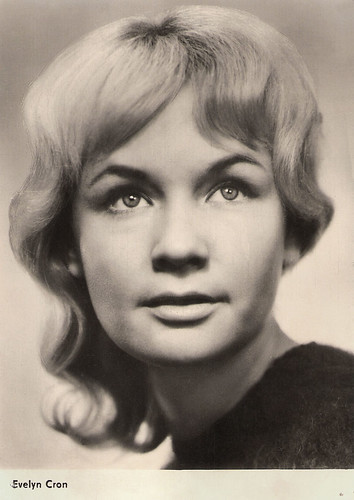
East-German card by VEB Progress Film-Vertrieb, no. 1434, 1961. Photo: Hans and Maria Lüdicke.
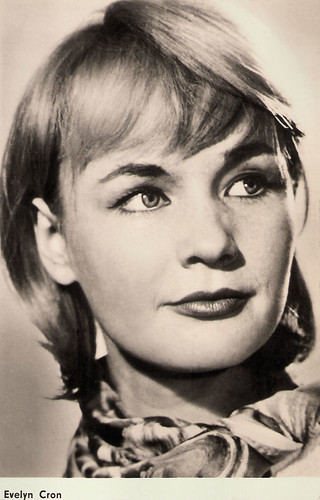
East-German card by VEB Progress Film-Vertrieb, no. 1815, 1963. Photo: Ludwig Schirmer.
Sources: Wikipedia (German) and .

East-German card by VEB Progress Film-Vertrieb, no. 2.605, 1966. Photo: DEWAG / Bundermann.

East-German card by VEB Progress Film-Vertrieb, no. 1.989, 1964. Photo: DEFA / Blümel.
Catwalk Model
Eevlyn Cron was born in 1940 in Magdeburg, Germany.
Already at school Cron played theatre. She learned the profession of a dental nurse. In her free time, she worked as a catwalk model for the Magdeburg fashion house Bormann.
At such an event, she was discovered by the DEFA, which was looking for an actress for the title role in the musical comedy Die schöne Lurette/The Beautiful Lurette (Gottfried Kolditz, 1960) with Jirí Papez and Otto Mellies .
After test shots she received the role of Lurette and a trainee contract with the German television, where she was trained from 1961 to 1963 to become an actress.
She made her stage debut as a guest in Jacques Deval's 'Stormy Crossing at Spiegelglatter See' at the Kammerspiele Leipzig. It was followed by engagements in Magdeburg and Berlin.

East-German card by VEB Progress Film-Vertrieb, no. 1364, 1960. Photo: DEFA / Schneider. Evelyn Cron in Die schöne Lurette/The Beautiful Lurette (Gottfried Kolditz, 1960).

East-German card by VEB Progress Film-Vertrieb, no. 2394, 1965. Photo: Schwarzer.
Departing the GDR
Evelyn Cron also became known for such films as the fairytale Die goldene Jurte/The golden yurt (Rawsha Dorshpalam, Gottfried Kolditz, 1961) - a coproduction with Mongolia.
Later followed the gangster comedy Hände hoch oder ich schieße/Hands Up or I'll Shoot (Hans-Joachim Kasprzik, 1966) with Rolf Herricht, which was forbidden by the GDR government. It had finally its premiere in 2009.
Evelyn Cron also appeared in the tragicomedy Der nackte Mann auf dem Sportplatz/The Naked Man in the Stadium (Konrad Wolf, 1974) featuring Kurt Böwe. Her last feature film was Jadup und Boel/Jadup and Boel (Rainer Simon, 1980), also with Kurt Böwe.
Furthermore, she was a permanent member in the actor ensemble of the East-German television and played in productions of the Moritzburg Television Theater such as Noel Coward's Ghost Comedy (1966), Curt Goetz' The Fairy Tale (1966), Eugène Scribes The Money Marriage (1970) and Paul Herbert Freyer's Brocade from France (1972).
Evelyn Cron departed the GDR in 1985. From 1988 to 1993 she had a permanent engagement at the Tribune in Berlin.
She continues to appear regularly on the German television. In 2014, she appeared in an episode of the Krimi series SOKO Wismar. SOKO is an abbreviation of the term 'Sonderkommission' (Special Commission - meaning special investigation team of the police in German). She also played in the TV comedy Das Gewinnerlos/The winner lot (Patrick Winczewski, 2015).

East-German card by VEB Progress Film-Vertrieb, no. 1434, 1961. Photo: Hans and Maria Lüdicke.

East-German card by VEB Progress Film-Vertrieb, no. 1815, 1963. Photo: Ludwig Schirmer.
Sources: Wikipedia (German) and .
Published on November 20, 2019 22:00
November 19, 2019
Vragoljanka (1919)
Vragoljanka is a silent film, produced in the former Kingdom of Serbs, Croatians and Slovenes, now Croatia. The film, directed by Alfred Grinhut a.k.a. Alfred Grünhut, was produced in 1918 by Croatia Film and distributed in 1919 by Jugoslavija Film in Zagreb. The film is considered lost. The rare, sepia postcards used for this post are from the collection of Ivo Blom.
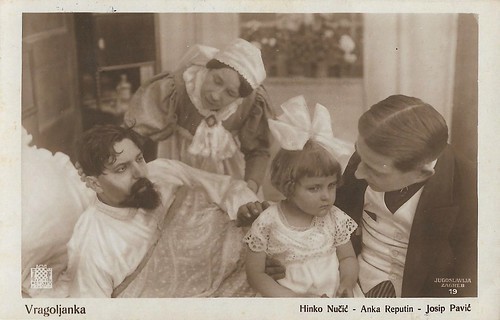
Former Kingdom of Yugoslavia (now Croatian) postcard by Jugoslavija Film, Zagreb, no. 19. Photo: Croatia Film. Josip Pavic (left), Anka Reputin (middle), and Hinko Nučić (right), in Vragoljanka (Alfred Grünhut, 1919). The little girl must be Vlasta Dryak.
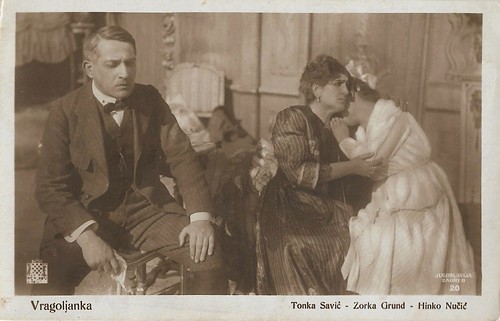
Former Kingdom of Yugoslavia (now Croatian) postcard by Jugoslavija Film, Zagreb, no. 20. Photo: Croatia Film. Hinko Nučić (left), Tonka Savić-Flieder-Macuka (middle), and Zorga Grund (right), in Vragoljanka (Alfred Grünhut, 1919).
A cheerful, somewhat scandalous tale of the bizarre ways of young women
Not much is known about this lost film. One critic, Peter Volk, described it as a cheerful, somewhat scandalous tale of the bizarre ways of young women in the contemporary environment. The second postcard below seems to confirm this interpretation. However, while two cards refer to the gay times of the elder people (Nina Vavra and Arnost Grund), several cards point at serious drama: bad news (a letter), a sick father, a depressed child, and a crying and gravely disappointed young woman. Is Zorka's character forced into marriage? Or plays Nuncic an uncle who becomes her tutor after her father dies? We may only speculate.
Zorka Kremzar, born Zorka Grund (1900-?), was a Croatian film actress. She was the daughter of Arnošt Grund, a director of the Czech origin, and sister of Milada Grund, who performed under the pseudonym of Milada Tana. Zorka Grund later became a filmmaker, according to Croatian sources.
Alfred Grinhut or Alfred Grünhut (1882-1946) was a Croatian and Yugoslav actor and director, known as the author of two films lost today: Vragoljanka (1919) and Dvije sirote (1919), in which he also acted. He also acted in Brisem i sudim (Arnost Grund, 1919) and Dvorovi u samoci (Tito Strozzi, 1925).
Hinko Nučić (originally: Nučič, 1883-1970) was a Slovenian theatre and film actor, director and theatrical pedagogue. He spent most of his artistic life at the Zagreb Theatre as a dramatist and director (1912-1918, 1921-1954). He taught at the Zagreb State Academy of Music (1922-1928) and at the Academy of Music until 1933. His wife and stage partner was Vika Podgorska.
After Vragoljanka, Nučić directed one silent film, Grička vještica (1920), based on a famous Croatian novel, while he also acted as supporting actor in a handful of sound films, first the German-Yugoslavian production Das Lied der schwarzen Berge/Fantom Durmitora (1933), starring Ita Rina . This was followed by Lisinski (Oktavijan Miletić, 1944), Ciguli Miguli (Branka Marjanovića, 1952), and Dobro morje (Mirko Grobler, 1958).
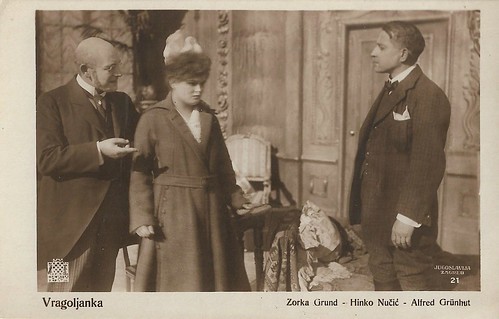
Former Kingdom of Yugoslavia (now Croatian) postcard by Jugoslavija Film, Zagreb, no. 21. Photo: Croatia Film. Zorka Grund (middle), Hinko Nučić (right), and Alfred Grünhut (left), in Vragoljanka (Alfred Grünhut, 1919).
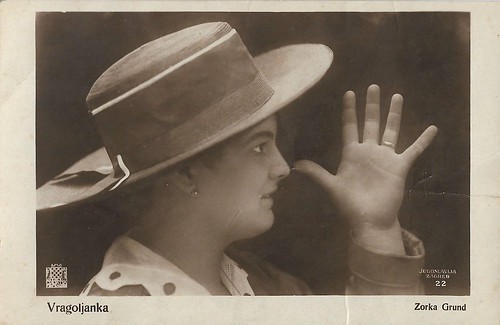
Former Kingdom of Yugoslavia (now Croatian) postcard by Jugoslavija Film, Zagreb, no. 22. Photo: Croatia Film. Zorka Grund in Vragoljanka (Alfred Grünhut, 1919).
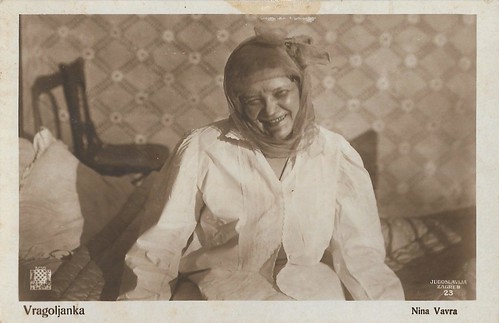
Former Kingdom of Yugoslavia (now Croatian) postcard by Jugoslavija Film, Zagreb, no. 23. Photo: Croatia Film. Nina Vavra in Vragoljanka (Alfred Grünhut, 1919).
See also our earlier posts on two silent films from the former Kingdom of Yugoslavia, Dama sa crnom krinkom/The Lady in the Black Mask (Robert Staerk 1918) and Dvije sirote/Dvije sirotice/The Two Orphans (Alfred Grinhut a.k.a. Alfred Grünhut, 1919). Both films were also produced by Croatia Film.

Former Kingdom of Yugoslavia (now Croatian) postcard by Jugoslavija Film, Zagreb, no. 19. Photo: Croatia Film. Josip Pavic (left), Anka Reputin (middle), and Hinko Nučić (right), in Vragoljanka (Alfred Grünhut, 1919). The little girl must be Vlasta Dryak.

Former Kingdom of Yugoslavia (now Croatian) postcard by Jugoslavija Film, Zagreb, no. 20. Photo: Croatia Film. Hinko Nučić (left), Tonka Savić-Flieder-Macuka (middle), and Zorga Grund (right), in Vragoljanka (Alfred Grünhut, 1919).
A cheerful, somewhat scandalous tale of the bizarre ways of young women
Not much is known about this lost film. One critic, Peter Volk, described it as a cheerful, somewhat scandalous tale of the bizarre ways of young women in the contemporary environment. The second postcard below seems to confirm this interpretation. However, while two cards refer to the gay times of the elder people (Nina Vavra and Arnost Grund), several cards point at serious drama: bad news (a letter), a sick father, a depressed child, and a crying and gravely disappointed young woman. Is Zorka's character forced into marriage? Or plays Nuncic an uncle who becomes her tutor after her father dies? We may only speculate.
Zorka Kremzar, born Zorka Grund (1900-?), was a Croatian film actress. She was the daughter of Arnošt Grund, a director of the Czech origin, and sister of Milada Grund, who performed under the pseudonym of Milada Tana. Zorka Grund later became a filmmaker, according to Croatian sources.
Alfred Grinhut or Alfred Grünhut (1882-1946) was a Croatian and Yugoslav actor and director, known as the author of two films lost today: Vragoljanka (1919) and Dvije sirote (1919), in which he also acted. He also acted in Brisem i sudim (Arnost Grund, 1919) and Dvorovi u samoci (Tito Strozzi, 1925).
Hinko Nučić (originally: Nučič, 1883-1970) was a Slovenian theatre and film actor, director and theatrical pedagogue. He spent most of his artistic life at the Zagreb Theatre as a dramatist and director (1912-1918, 1921-1954). He taught at the Zagreb State Academy of Music (1922-1928) and at the Academy of Music until 1933. His wife and stage partner was Vika Podgorska.
After Vragoljanka, Nučić directed one silent film, Grička vještica (1920), based on a famous Croatian novel, while he also acted as supporting actor in a handful of sound films, first the German-Yugoslavian production Das Lied der schwarzen Berge/Fantom Durmitora (1933), starring Ita Rina . This was followed by Lisinski (Oktavijan Miletić, 1944), Ciguli Miguli (Branka Marjanovića, 1952), and Dobro morje (Mirko Grobler, 1958).

Former Kingdom of Yugoslavia (now Croatian) postcard by Jugoslavija Film, Zagreb, no. 21. Photo: Croatia Film. Zorka Grund (middle), Hinko Nučić (right), and Alfred Grünhut (left), in Vragoljanka (Alfred Grünhut, 1919).

Former Kingdom of Yugoslavia (now Croatian) postcard by Jugoslavija Film, Zagreb, no. 22. Photo: Croatia Film. Zorka Grund in Vragoljanka (Alfred Grünhut, 1919).

Former Kingdom of Yugoslavia (now Croatian) postcard by Jugoslavija Film, Zagreb, no. 23. Photo: Croatia Film. Nina Vavra in Vragoljanka (Alfred Grünhut, 1919).
See also our earlier posts on two silent films from the former Kingdom of Yugoslavia, Dama sa crnom krinkom/The Lady in the Black Mask (Robert Staerk 1918) and Dvije sirote/Dvije sirotice/The Two Orphans (Alfred Grinhut a.k.a. Alfred Grünhut, 1919). Both films were also produced by Croatia Film.
Published on November 19, 2019 22:00
November 18, 2019
Artists and Models
Today, EFSP collaborator Ivo Blom will give a paper at a symposium at the Centre National pour la Cinématographie (CNC, Paris), within the framework of the Franco-Italian-Dutch research project LE CINÉMA MUET ITALIEN À LA CROISÉE DES ARTS EUROPÉENS (1896-1930). He will talk about the importance of painting, literature and theatre for two silent films with Italian diva Italia Almirante Manzini: Femmina (Augusto Genina, 1918) and L’ombra (Mario Almirante, 1923). Thus today's blog post is dedicated to the representation of artists and their models in the European silent cinema.
German samples
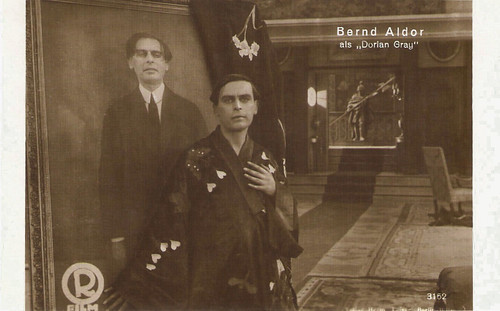
German postcard by Hermann Leiser Verlag, Berlin, no. 3152. Photo: Richard-Oswald-Produktion. Bernd Aldor in Das Bildnis des Dorian Gray/The Picture of Dorian Gray (Richard Oswald, 1917).
While Dorian remains the same beautiful young man in Das Bildnis des Dorian Gray/The Picture of Dorian Gray, his 'picture' becomes older, uglier, more depraved. Oscar Wilde’s haunting tale was filmed various times.
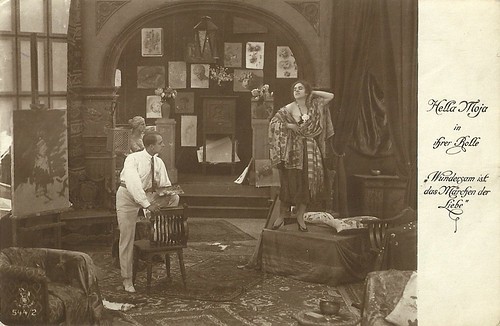
German postcard by Rotophot in the Film-Sterne series, no. 544/2. Photo: Hella Moja-Film GmbH. Hella Moja and Ernst Hofmann in Wundersam ist das Märchen der Liebe/Wonderful is the Fairy-Tale of Love (Leo Connard, 1918).
Cinema’s vision of the painter’s studio often has the model standing on a pedestal, the painter dressed in immaculate clothing, and the floor covered with oriental rugs.
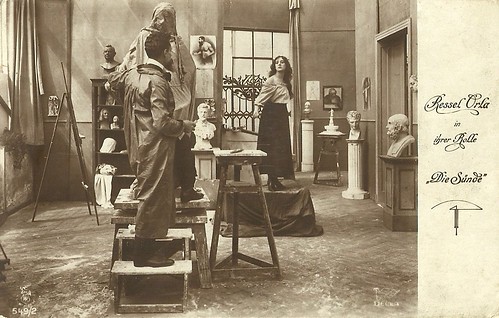
German postcard by Rotphot in the Film Sterne series, no. 549/2. Photo: Decla. Ressel Orla in Die Sünde/The Sin (Alwin Neuss, 1918).
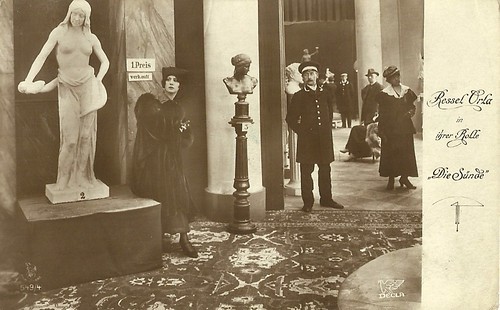
German postcard by Rotophot in the Film Sterne series, no. 549/4. Photo: Decla. Ressel Orla in Die Sünde/The Sin (Alwin Neuss, 1917).
“In Sin, Ressel Orla has first to play the young thing, who becomes an artist's model under the force of circumstances, in order to save her dying father. When she later stands alone in the world, she rises to happiness without suffering from her past. But then the pride of the woman awakens in her, to whom only the right of her own ego applies.” ( Lichtbild-Bühne , 13.07.1918). As often happens in 1910s cinema, the model is ashamed by the artwork based on her own nudity when publicly exhibited, and even awarded.
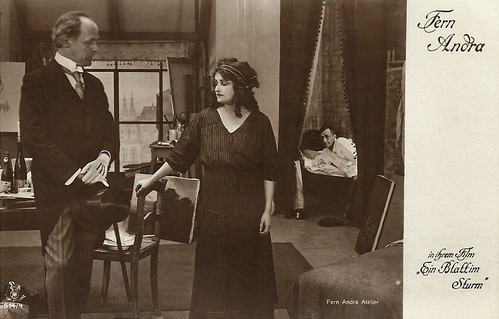
German postcard by Rotophot in the Film-Sterne series, no. 514/4. Photo: Fern Andra Atelier. Fern Andra and (in the back) Alfred Abel in Ein Blatt im Sturm... doch das Schicksal hat es verweht/A leaf in a storm ... but fate has lost it (Fern Andra, 1917).
In 1910s cinema, the female partners of artists often need to help them out by selling their art, or even their own bodies.
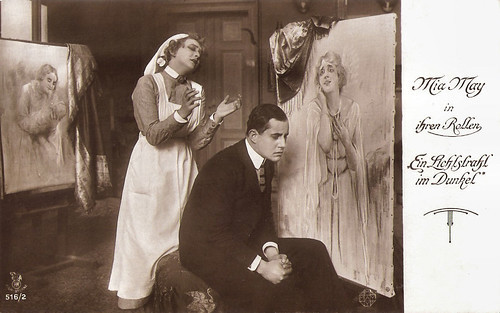
German postcard by Rotophot in the Film Sterne series, no. 516/2. Photo: May Film. Mia May and Bruno Kastner in Ein Lichtstrahl im Dunkel/A Ray of Light in the Dark (Joe May, 1917).
Count Gerd Palm (Kastner) is known for his flattering portraits of his models, so countess Lydia von Grabor (May), who has a hideous nose, asks him to paint her. Gerd sees through her facade and paints her as a lovely mother. He is so enchanted by a song from her that he asks her marry him. Lydia cannot believe him, so he flees. Years pass, the counts has her nose operated, and returns to Gerd, but discovers he has become blind. Dressed as a nurse she takes care of him. Her care makes him retake his work. He hears she is now ready to marry him, but when he still doubts she sings the song she once sang for him and they finally unite.
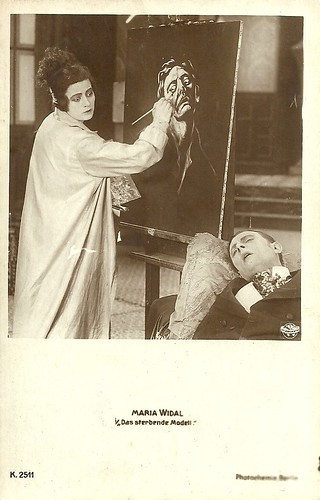
German postcard by Photochemie, no. K. 2511. Photo: Saturn-Film. Maria Widal in Das sterbende Modell/The dying model (Urban Gad, 1918).
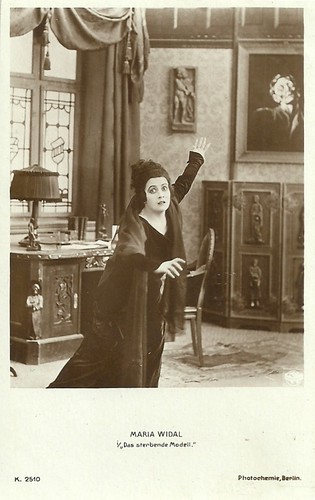
German postcard by Photochemie, no. K. 2510. Photo: Saturn-Film. Maria Widal in Das sterbende Modell/The dying model (Urban Gad, 1918).
Das sterbende Modell seems to have been a variation on Edgar Allen Poe’s 'The Oval Portrait'. The more the model is painted, the more she weakens and eventually dies. Painted portraits may have devastating effects on their models.
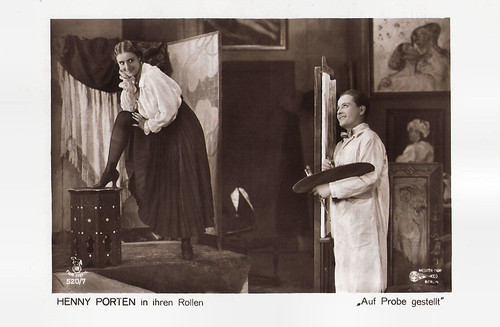
German postcard in the Film Sterne series by Rotophot, no. 520/7. Photo: Messter Film, Berlin. Henny Porten and Hermann Thimig in Auf Probe gestellt/Put to the test (Rudolf Biebrach, 1918).
Comedies with artists are rather rare in the 1910s, but a good example is this Henny Porten comedy. As 1910s film convention demands it, the countess prefers the poor, handsome painter to a rich and stupid aristocrat.
Two examples from the French and the Danish cinema
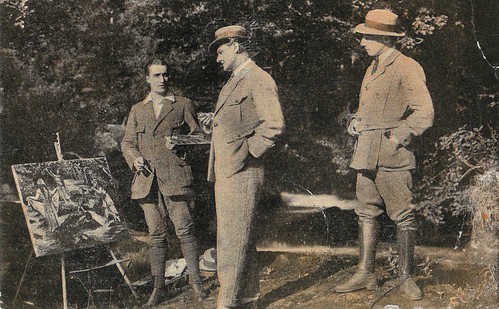
Spanish collectors card by Amattler Marca Luna chocolate, Series 6, no. 2. Photo: Eclipse. Fred Zorilla and Jean Aymé in Lorena (Georges Tréville, 1918)
Lorena ( Suzanne Grandais ) is the daughter of the marquis of Chambrey (Maillard), and secretly engaged to the painter Pierre Laurent (Fred Zorilla), but her father has other plans. He wants to give her hand to Count Borgo (Jean Aymé), a son of a late friend. As mentioned above, poor but young, handsome, romantic artists were often opposed to old, rich, depraved, and cynic or stupid aristocrats.
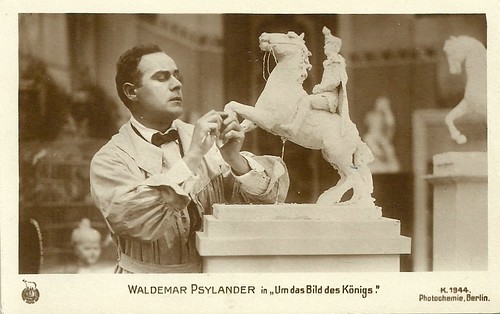
German postcard by Photochemie, Berlin, no. K. 1944. Photo: Nordisk Films. Valdemar Psilander in Rytterstatuen (A.W. Sandberg, 1919). The German title is Um das Bild des Königs (For the king's statue).
A young sculptor is commissioned by the Minister to make an equestrian statue of the King, for a high sum of money. He also meets and falls in love with the Minister’s niece. Her father, a banker, is involved in wild speculation, kills himself and leaves a giant debt. Secretly, the artist helps out with his prize money, winning the girl of course. So the artist is not only talented but also a gentleman.
Examples of Italian silent films with Francesca Bertini and Helena Makowska
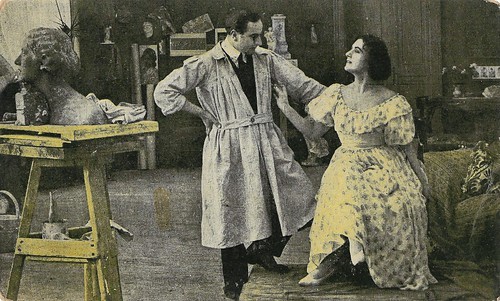
Spanish postcard by Amatller Marca Luna chocolate, Series 2a, no. 6. Photo: Caesar Film. Gustavo Serena and Francesca Bertini in Il processo Clémenceau (Alfredo De Antoni, 1917). In Spain, the film was released as El proceso Clemenceau.
Il processo Clemenceau (Alfredo De Antoni, 1917) is typical for the parabolas in film plots on artists and their models. Artists discover models, often as young, beautiful and innocent girls. Gradually, the women become depraved thanks to the success of the artists, get hooked on money and luxury, and start to cheat. When the sculptor discovers his lover’s betrayal, he first will smash the plaster bust. In the end he will kill the model too. The artist creates the art work and also the model, but when the model misbehaves and does not correspond anymore with the art work’s purity, he may also destroy both the art work and the model. On the left of the card, a copy of a bust made by Amleto Cataldi, portraying Francesca Bertini , and published in the art journal Emporium in 1917.
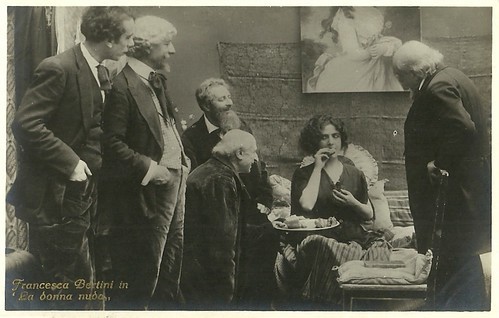
Italian postcard by G.B. Falci, Milano, no. 257. Photo: Caesar Film. Francesca Bertini in La donna nuda (Roberto Roberti, 1922), film adaptation of Henry Bataille's classic play La femme nue (1908).
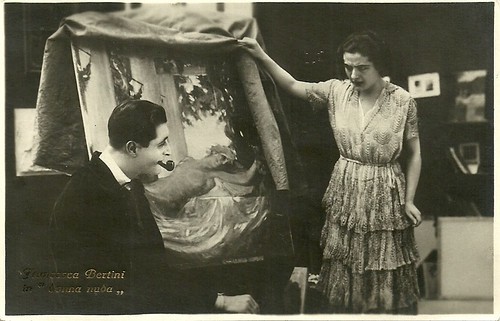
Italian postcard by La Fotominio / Ed. G.B. Falci, Milano, no. 115. Photo: Caesar Film. Francesca Bertini and Angelo Ferrari in the Henry Bataille adaptation La donna nuda (Roberto Roberti, 1922).
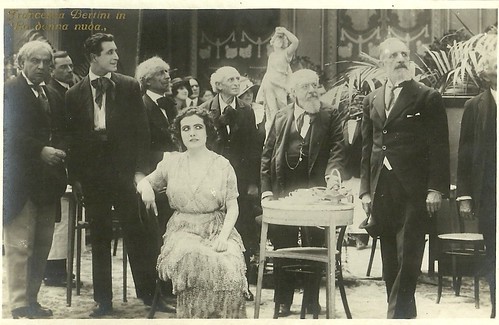
Italian postcard by La Fotominio / Ed. G.B. Falci, Milano, no. 264. Photo: Caesar Film. Angelo Ferrari and Francesca Bertini in the Henry Bataille adaptation La donna nuda (Roberto Roberti, 1922).
In La donna nuda (Roberto Roberti, 1920), the painter Pierre Bernier ( Angelo Ferrari ) becomes acquainted with Lolette ( Francesca Bertini ), the model of his old friend Rouchard, picked up from the street. Lolette becomes Pierre’s model and his mistress. Pierre becomes famous thanks to his portrait 'The Naked Woman' which represents Lolette. The evening of his triumph at the Salon he decides to marry her, but after having become rich and famous he falls in love with the Princess of Chaban and abandons Lolette, despite owing her his success. After a suicide attempt over her persistently infidel lover, Lolette recovers in the hospital, rejects Pierre, and decides to return to Rouchard. The film was a remake of a film with Lyda Borelli , made in 1914 by Carmine Gallone, while several sound adaptations of Bataille's play would follow.
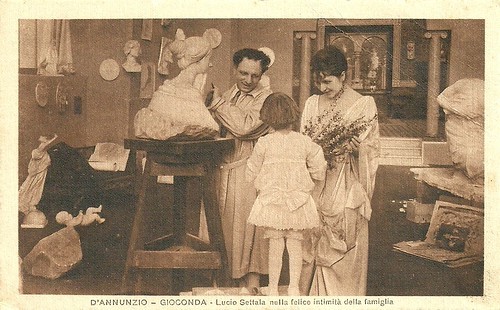
Italian postcard by IPA CT, no. 3654, V. Uff. Rev. St., Terni. Photo: Ambrosio. Umberto Mozzato as Settala and Mercedes Brignone as his wife Silvia in La Gioconda (Eleuterio Rodolfi 1916, released 1917), based on Gabriele D'Annunzio's play. Caption: 'Lucio Settala in the happy intimacy of the family.'
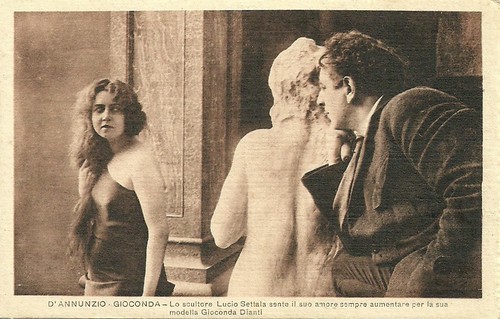
Italian postcard by IPA CT, no. 3877, V. Uff. Rev. St., Terni. Photo: Ambrosio. Umberto Mozzato as Lucio Settala and Helena Makowska as Gioconda Dianti in La Gioconda (1917).Caption: Sculptor Lucio Settala feels his love for his model Gioconda Dianti is ever expanding.
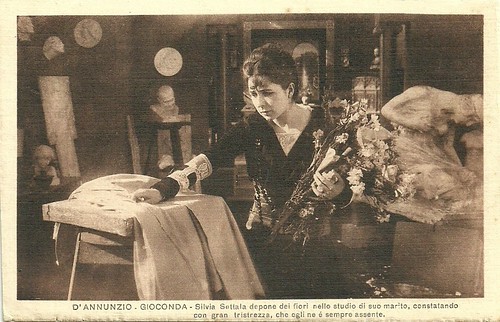
Italian postcard by IPA CT, no. 3871. Photo: Società Ambrosio, Torino. V. Uff. Rev. St. Terni. Mercedes Brignone in La Gioconda (Eleuterio Rodolfi, 1917). Caption: Sivia Settala deposes flowers in the studio of her husband, constating with great sadness, that he is ever more absent.
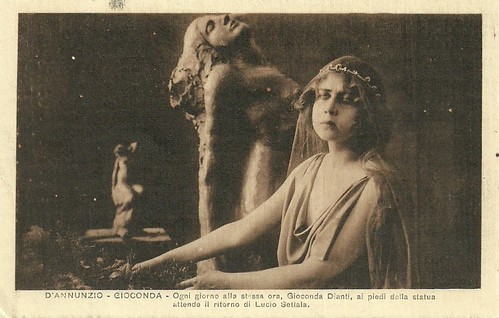
Italian postcard. IPA CT, no. 3662. Photo: Società Ambrosio, Torino. Helena Makowska as the model Gioconda Dianti in La Gioconda (Eleuterio Rodolfi, 1917).
Postcards for the lost Ambrosio production La Gioconda (Eleuterio Rodolfi, 1916, released 1917), based on Gabriele D'Annunzio's play, and starring Helena Makowska , Umberto Mozzato, and Mercedes Brignone . The statue for which Gioconda Danti poses does not seem to recall any existing statue, but its style reminds of that of the Italian sculptor Leonardo Bistolfi. As was common in silent films on artists, the actor’s studio is full of plasters referring to Antique and modern sculpture.
An example with a male protagonist
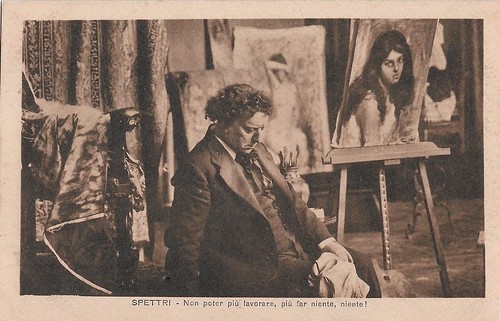
Italian postcard. Photo: Milano Film. Ermete Zacconi in Spettri/Gli spettri (A.G. Caldiera, 1918). Caption: Not being able anymore to paint, to do anything, nothing!
Ermete Zacconi in the Italian silent film Spettri/Gli spettri (A.G. Caldiera, 1918), adapted from Henrik Ibsen's play 'Ghosts' (Gengangere, 1881). Caption: Not being able anymore to paint, to do anything, nothing! Oswald Alving, who has been a painter in Paris, returns home, suffering from depressions. He gets into a state of despair and anguish, when his mother reveals him the woman he loves is his half-sister and he is himself suffering of syphilis, inherited from his father. He asks his mother to help him die by an overdose of morphine in order to end his suffering from his disease, which could put him into a helpless vegetative state.
Two films with Italia Almirante Manzini
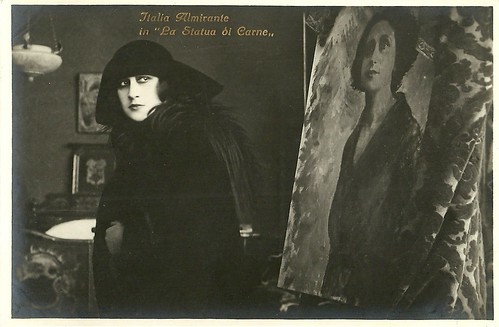
Italian postcard by Fotominio, no. 52. Photo: G.B. Falci, Milano. Italia Almirante in La statua di carne (Mario Almirante 1921). Noemi Keller notices the painted portrait of her lookalike Maria, who has died and whom the painter, count Paolo, is still loving, through Noemi.
La statua di carne (Mario Almirante, 1921), starring Italia Almirante Manzini and Lido Manetti . Often in film, deceased persons affect the living ones by their painted portraits. When discovering a painted portrait of the deceased ‘midinette’ Maria, who is her exact lookalike, the mundane stage artist Noemi Keller understands why count Paolo is so obsessed with her. The motif of the Doppelgänger was popular in silent film and in literature. Though based on an original play (1862, by Teobaldo Ciconi, which was already adapted to film in Italy in 1912, the plot of La statua di carne may also remind of the Symbolist novel 'Bruges-la-morte' (1892) by Georges Rodenbach, which inspired various films such as Yevgeni Bauer’s Gryozy/ Daydreams (1915) and Alfred Hitchcock’s Vertigo (1959).
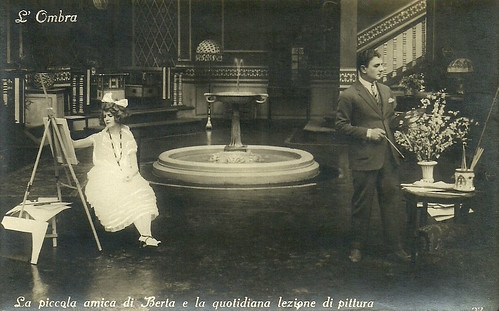
Italian postcard by Ed. Ballerini & Fratini, Firenze. Photo: Liliana Ardea and Alberto Collo in L'ombra (Mario Almirante, 1923). Caption: Berta's little friend and the daily painting lesson.
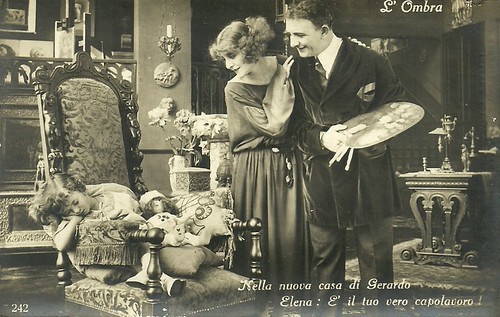
Italian postcard by Ed. Ballerini & Fratini, Firenze, no. 242. Photo: Liliana Ardea and Alberto Collo in L'ombra (Mario Almirante, 1923). Caption: In the new house of Gerardo. Elena: He is your real masterpiece!
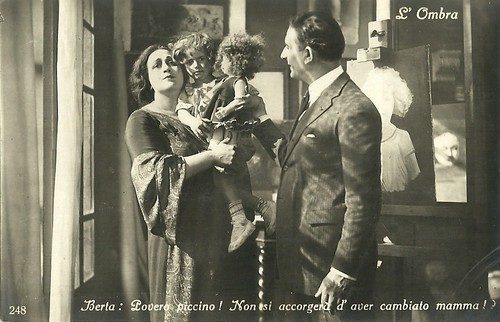
Italian postcard by Ed. Ballerini & Fratini, Firenze, no. 248. Photo: Italia Almirante Manzini and Alberto Collo in L'ombra (Mario Almirante, 1923). Caption: Berta: Poor little one! He won't realise to have changed mother. This image represents the final scene of the film.
In L’ombra (Mario Almirante, 1924), Berta ( Italia Almirante Manzini ) is paralysed. Her husband Gerardo ( Alberto Collo ), an acclaimed painter, starts a double life with Elena (Liliana Ardea), a former pupil. He even has a child with her. The paralysed woman heals, discovers the fraud, and is devastated, preferring to get paralysed again. In the end, the second woman exits, leaving even her child behind. Mark the unfinished portrait of the child on the right. In the play by Dario Niccodemi, on which the film is based, the interior of the painter’s house is described as being full with portraits of the child.
Sources: Ivo Blom, ‘Of Artists and Models. Italian Silent Cinema between Narrative Convention and Artistic Practice’ (Acta Sapientiae Universitatis. Film and Media Studies 7, 2013, 97-110) and Francesco Geraci, ‘Artisti contemporanei: Amleto Cataldi’ (Emporium, XLV, Vol. 267, March 1917, pp. 163-175).
German samples

German postcard by Hermann Leiser Verlag, Berlin, no. 3152. Photo: Richard-Oswald-Produktion. Bernd Aldor in Das Bildnis des Dorian Gray/The Picture of Dorian Gray (Richard Oswald, 1917).
While Dorian remains the same beautiful young man in Das Bildnis des Dorian Gray/The Picture of Dorian Gray, his 'picture' becomes older, uglier, more depraved. Oscar Wilde’s haunting tale was filmed various times.

German postcard by Rotophot in the Film-Sterne series, no. 544/2. Photo: Hella Moja-Film GmbH. Hella Moja and Ernst Hofmann in Wundersam ist das Märchen der Liebe/Wonderful is the Fairy-Tale of Love (Leo Connard, 1918).
Cinema’s vision of the painter’s studio often has the model standing on a pedestal, the painter dressed in immaculate clothing, and the floor covered with oriental rugs.

German postcard by Rotphot in the Film Sterne series, no. 549/2. Photo: Decla. Ressel Orla in Die Sünde/The Sin (Alwin Neuss, 1918).

German postcard by Rotophot in the Film Sterne series, no. 549/4. Photo: Decla. Ressel Orla in Die Sünde/The Sin (Alwin Neuss, 1917).
“In Sin, Ressel Orla has first to play the young thing, who becomes an artist's model under the force of circumstances, in order to save her dying father. When she later stands alone in the world, she rises to happiness without suffering from her past. But then the pride of the woman awakens in her, to whom only the right of her own ego applies.” ( Lichtbild-Bühne , 13.07.1918). As often happens in 1910s cinema, the model is ashamed by the artwork based on her own nudity when publicly exhibited, and even awarded.

German postcard by Rotophot in the Film-Sterne series, no. 514/4. Photo: Fern Andra Atelier. Fern Andra and (in the back) Alfred Abel in Ein Blatt im Sturm... doch das Schicksal hat es verweht/A leaf in a storm ... but fate has lost it (Fern Andra, 1917).
In 1910s cinema, the female partners of artists often need to help them out by selling their art, or even their own bodies.

German postcard by Rotophot in the Film Sterne series, no. 516/2. Photo: May Film. Mia May and Bruno Kastner in Ein Lichtstrahl im Dunkel/A Ray of Light in the Dark (Joe May, 1917).
Count Gerd Palm (Kastner) is known for his flattering portraits of his models, so countess Lydia von Grabor (May), who has a hideous nose, asks him to paint her. Gerd sees through her facade and paints her as a lovely mother. He is so enchanted by a song from her that he asks her marry him. Lydia cannot believe him, so he flees. Years pass, the counts has her nose operated, and returns to Gerd, but discovers he has become blind. Dressed as a nurse she takes care of him. Her care makes him retake his work. He hears she is now ready to marry him, but when he still doubts she sings the song she once sang for him and they finally unite.

German postcard by Photochemie, no. K. 2511. Photo: Saturn-Film. Maria Widal in Das sterbende Modell/The dying model (Urban Gad, 1918).

German postcard by Photochemie, no. K. 2510. Photo: Saturn-Film. Maria Widal in Das sterbende Modell/The dying model (Urban Gad, 1918).
Das sterbende Modell seems to have been a variation on Edgar Allen Poe’s 'The Oval Portrait'. The more the model is painted, the more she weakens and eventually dies. Painted portraits may have devastating effects on their models.

German postcard in the Film Sterne series by Rotophot, no. 520/7. Photo: Messter Film, Berlin. Henny Porten and Hermann Thimig in Auf Probe gestellt/Put to the test (Rudolf Biebrach, 1918).
Comedies with artists are rather rare in the 1910s, but a good example is this Henny Porten comedy. As 1910s film convention demands it, the countess prefers the poor, handsome painter to a rich and stupid aristocrat.
Two examples from the French and the Danish cinema

Spanish collectors card by Amattler Marca Luna chocolate, Series 6, no. 2. Photo: Eclipse. Fred Zorilla and Jean Aymé in Lorena (Georges Tréville, 1918)
Lorena ( Suzanne Grandais ) is the daughter of the marquis of Chambrey (Maillard), and secretly engaged to the painter Pierre Laurent (Fred Zorilla), but her father has other plans. He wants to give her hand to Count Borgo (Jean Aymé), a son of a late friend. As mentioned above, poor but young, handsome, romantic artists were often opposed to old, rich, depraved, and cynic or stupid aristocrats.

German postcard by Photochemie, Berlin, no. K. 1944. Photo: Nordisk Films. Valdemar Psilander in Rytterstatuen (A.W. Sandberg, 1919). The German title is Um das Bild des Königs (For the king's statue).
A young sculptor is commissioned by the Minister to make an equestrian statue of the King, for a high sum of money. He also meets and falls in love with the Minister’s niece. Her father, a banker, is involved in wild speculation, kills himself and leaves a giant debt. Secretly, the artist helps out with his prize money, winning the girl of course. So the artist is not only talented but also a gentleman.
Examples of Italian silent films with Francesca Bertini and Helena Makowska

Spanish postcard by Amatller Marca Luna chocolate, Series 2a, no. 6. Photo: Caesar Film. Gustavo Serena and Francesca Bertini in Il processo Clémenceau (Alfredo De Antoni, 1917). In Spain, the film was released as El proceso Clemenceau.
Il processo Clemenceau (Alfredo De Antoni, 1917) is typical for the parabolas in film plots on artists and their models. Artists discover models, often as young, beautiful and innocent girls. Gradually, the women become depraved thanks to the success of the artists, get hooked on money and luxury, and start to cheat. When the sculptor discovers his lover’s betrayal, he first will smash the plaster bust. In the end he will kill the model too. The artist creates the art work and also the model, but when the model misbehaves and does not correspond anymore with the art work’s purity, he may also destroy both the art work and the model. On the left of the card, a copy of a bust made by Amleto Cataldi, portraying Francesca Bertini , and published in the art journal Emporium in 1917.

Italian postcard by G.B. Falci, Milano, no. 257. Photo: Caesar Film. Francesca Bertini in La donna nuda (Roberto Roberti, 1922), film adaptation of Henry Bataille's classic play La femme nue (1908).

Italian postcard by La Fotominio / Ed. G.B. Falci, Milano, no. 115. Photo: Caesar Film. Francesca Bertini and Angelo Ferrari in the Henry Bataille adaptation La donna nuda (Roberto Roberti, 1922).

Italian postcard by La Fotominio / Ed. G.B. Falci, Milano, no. 264. Photo: Caesar Film. Angelo Ferrari and Francesca Bertini in the Henry Bataille adaptation La donna nuda (Roberto Roberti, 1922).
In La donna nuda (Roberto Roberti, 1920), the painter Pierre Bernier ( Angelo Ferrari ) becomes acquainted with Lolette ( Francesca Bertini ), the model of his old friend Rouchard, picked up from the street. Lolette becomes Pierre’s model and his mistress. Pierre becomes famous thanks to his portrait 'The Naked Woman' which represents Lolette. The evening of his triumph at the Salon he decides to marry her, but after having become rich and famous he falls in love with the Princess of Chaban and abandons Lolette, despite owing her his success. After a suicide attempt over her persistently infidel lover, Lolette recovers in the hospital, rejects Pierre, and decides to return to Rouchard. The film was a remake of a film with Lyda Borelli , made in 1914 by Carmine Gallone, while several sound adaptations of Bataille's play would follow.

Italian postcard by IPA CT, no. 3654, V. Uff. Rev. St., Terni. Photo: Ambrosio. Umberto Mozzato as Settala and Mercedes Brignone as his wife Silvia in La Gioconda (Eleuterio Rodolfi 1916, released 1917), based on Gabriele D'Annunzio's play. Caption: 'Lucio Settala in the happy intimacy of the family.'

Italian postcard by IPA CT, no. 3877, V. Uff. Rev. St., Terni. Photo: Ambrosio. Umberto Mozzato as Lucio Settala and Helena Makowska as Gioconda Dianti in La Gioconda (1917).Caption: Sculptor Lucio Settala feels his love for his model Gioconda Dianti is ever expanding.

Italian postcard by IPA CT, no. 3871. Photo: Società Ambrosio, Torino. V. Uff. Rev. St. Terni. Mercedes Brignone in La Gioconda (Eleuterio Rodolfi, 1917). Caption: Sivia Settala deposes flowers in the studio of her husband, constating with great sadness, that he is ever more absent.

Italian postcard. IPA CT, no. 3662. Photo: Società Ambrosio, Torino. Helena Makowska as the model Gioconda Dianti in La Gioconda (Eleuterio Rodolfi, 1917).
Postcards for the lost Ambrosio production La Gioconda (Eleuterio Rodolfi, 1916, released 1917), based on Gabriele D'Annunzio's play, and starring Helena Makowska , Umberto Mozzato, and Mercedes Brignone . The statue for which Gioconda Danti poses does not seem to recall any existing statue, but its style reminds of that of the Italian sculptor Leonardo Bistolfi. As was common in silent films on artists, the actor’s studio is full of plasters referring to Antique and modern sculpture.
An example with a male protagonist

Italian postcard. Photo: Milano Film. Ermete Zacconi in Spettri/Gli spettri (A.G. Caldiera, 1918). Caption: Not being able anymore to paint, to do anything, nothing!
Ermete Zacconi in the Italian silent film Spettri/Gli spettri (A.G. Caldiera, 1918), adapted from Henrik Ibsen's play 'Ghosts' (Gengangere, 1881). Caption: Not being able anymore to paint, to do anything, nothing! Oswald Alving, who has been a painter in Paris, returns home, suffering from depressions. He gets into a state of despair and anguish, when his mother reveals him the woman he loves is his half-sister and he is himself suffering of syphilis, inherited from his father. He asks his mother to help him die by an overdose of morphine in order to end his suffering from his disease, which could put him into a helpless vegetative state.
Two films with Italia Almirante Manzini

Italian postcard by Fotominio, no. 52. Photo: G.B. Falci, Milano. Italia Almirante in La statua di carne (Mario Almirante 1921). Noemi Keller notices the painted portrait of her lookalike Maria, who has died and whom the painter, count Paolo, is still loving, through Noemi.
La statua di carne (Mario Almirante, 1921), starring Italia Almirante Manzini and Lido Manetti . Often in film, deceased persons affect the living ones by their painted portraits. When discovering a painted portrait of the deceased ‘midinette’ Maria, who is her exact lookalike, the mundane stage artist Noemi Keller understands why count Paolo is so obsessed with her. The motif of the Doppelgänger was popular in silent film and in literature. Though based on an original play (1862, by Teobaldo Ciconi, which was already adapted to film in Italy in 1912, the plot of La statua di carne may also remind of the Symbolist novel 'Bruges-la-morte' (1892) by Georges Rodenbach, which inspired various films such as Yevgeni Bauer’s Gryozy/ Daydreams (1915) and Alfred Hitchcock’s Vertigo (1959).

Italian postcard by Ed. Ballerini & Fratini, Firenze. Photo: Liliana Ardea and Alberto Collo in L'ombra (Mario Almirante, 1923). Caption: Berta's little friend and the daily painting lesson.

Italian postcard by Ed. Ballerini & Fratini, Firenze, no. 242. Photo: Liliana Ardea and Alberto Collo in L'ombra (Mario Almirante, 1923). Caption: In the new house of Gerardo. Elena: He is your real masterpiece!

Italian postcard by Ed. Ballerini & Fratini, Firenze, no. 248. Photo: Italia Almirante Manzini and Alberto Collo in L'ombra (Mario Almirante, 1923). Caption: Berta: Poor little one! He won't realise to have changed mother. This image represents the final scene of the film.
In L’ombra (Mario Almirante, 1924), Berta ( Italia Almirante Manzini ) is paralysed. Her husband Gerardo ( Alberto Collo ), an acclaimed painter, starts a double life with Elena (Liliana Ardea), a former pupil. He even has a child with her. The paralysed woman heals, discovers the fraud, and is devastated, preferring to get paralysed again. In the end, the second woman exits, leaving even her child behind. Mark the unfinished portrait of the child on the right. In the play by Dario Niccodemi, on which the film is based, the interior of the painter’s house is described as being full with portraits of the child.
Sources: Ivo Blom, ‘Of Artists and Models. Italian Silent Cinema between Narrative Convention and Artistic Practice’ (Acta Sapientiae Universitatis. Film and Media Studies 7, 2013, 97-110) and Francesco Geraci, ‘Artisti contemporanei: Amleto Cataldi’ (Emporium, XLV, Vol. 267, March 1917, pp. 163-175).
Published on November 18, 2019 22:00
November 17, 2019
New finds at the The International Collectors Fair 2019
Last weekend, Utrecht hosted once again 'The International Collectors Fair', Europe’s biggest Vintage Event. A flu kept me from travelling to Utrecht, but Ivo Blom went and found some new treasures which we like to share with you today. Here are 15 of Ivo's finds.
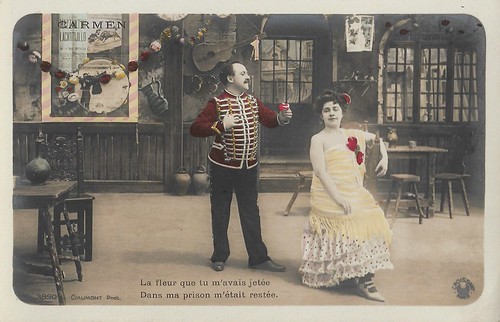
French postcard by Croissant, Paris, no. 3890. Photo: Gaumont phot. Caption: Don José declares his love to Carmen. This card is probably for the 1906 film Carmen , directed by Alice Guy (-Blaché) for Gaumont. The film consisted of 12 so-called phonoscènes, an early sound-on-disc system. The second song/film scene was 'La fleur que tu m'avais jetée'. The film is presumed lost. Unknown is who the singers are. Croissant also released the coloured series of postcards for pre-1910 Pathé frères movies.
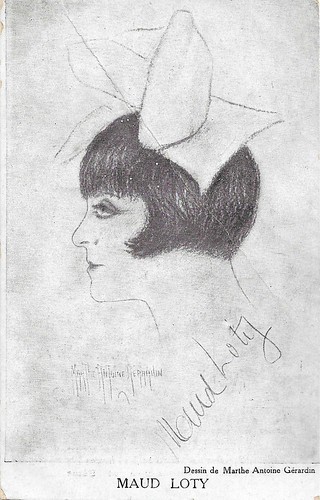
French publicity card. Drawing by Marthe Antoine Gérardin. Publicity for the play 'Chipee!' at the Théâtre de l'Avenue in Paris, a play in which Maud Loty also sang. Her co-actors were a.o. Jean Dax and Marguerite Moreno .
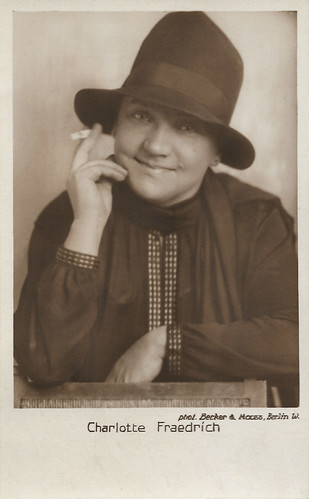
German postcard. Photo Becker & Maass, Berlin. As far as known, stage actress Charlotte Fraedrich only acted in one film, the short Der vertauschte Hund/The swapped dog (Kurt Bleines, 1937), but this postcard must date from the 1910s.
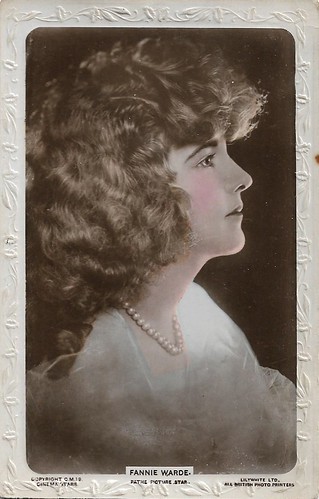
British postcard in the Cinema Stars series by Lilywhite Ltd., no. C.M. 19. Photo: Pathé. Fannie Ward's name is misspelled on this card.
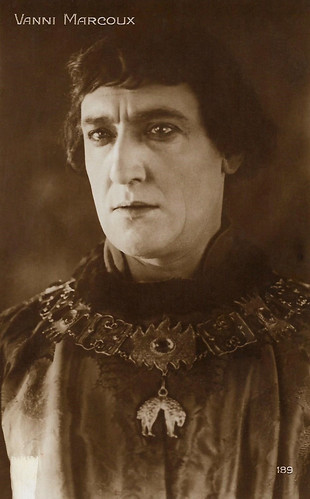
French postcard by Cinémagazine-Edition, no. 189. Vanni Marcoux as Charles le Téméraire (Charles the Bold) in the French silent film Le Miracle des Loups (Raymond Bernard, 1924).
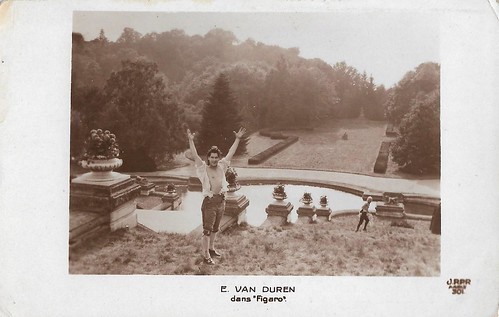
French postcard by JRPR, Paris, no. 301. Ernst / Edmond Van Duren in the French late silent film Figaro (Gaston Ravel, 1929), based on the play by Pierre Beaumarchais. Van Duren played the title role. Location shooting was done at the Château de Rochefort-sur-Yvelines.
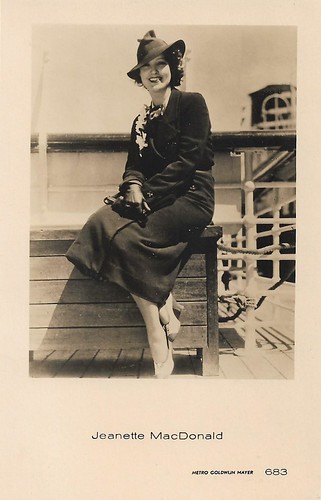
Dutch postcard, no. 683. Photo: Metro Goldwyn Mayer. This photo could be related to Jeanette MacDonald's 1933 visit to the Netherlands.

Belgian postcard by Esclamator. Photo: Jan Vanderheyden-Film. Jef Bruyninckx in De Witte/Whitey (Jan Vanderheyden, 1934), based on the eponymous novel by Ernest Claes. In 1980 a new adaptation by Robbe De Hert would follow.
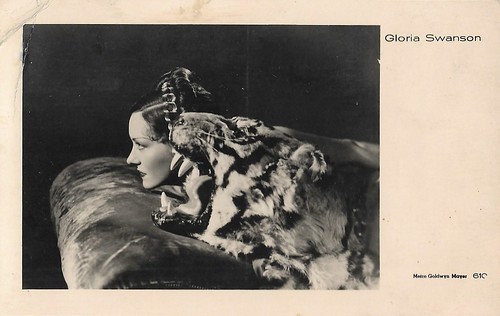
Dutch postcard, no. 610. Photo: Metro Goldwyn Mayer. In 1934 Gloria Swanson did a photo shoot involving this tiger rug and hairdo, before acting in the Jerome Kern musical Music in the air (Joe May, 1934). While some sources say the photos were made by Clarence Sinclair Bull, other sources silence the photographer.
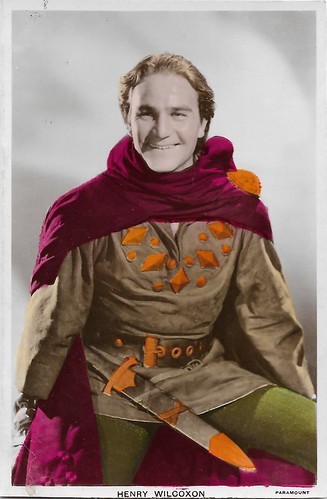
British postcard in the Colourgraph Series, no. C248. Photo: Paramount. Henry Wilcoxon as King Richard in the period piece The Crusades (Cecil B. DeMille, 1935).
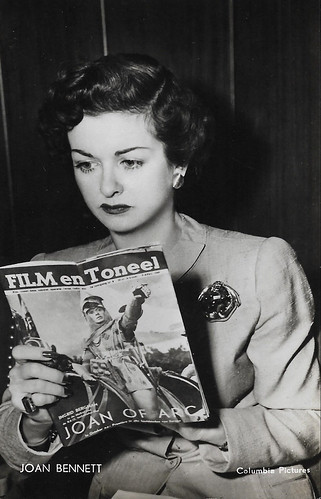
Belgian postcard by Film en Toneel, no. AX 141. Photo: Columbia Pictures. Joan Bennett pretending to read the Dutch-Flemish film magazine 'Film and Tooneel' (Film and Theatre). On the cover of the magazine is a still from Joan of Arc (Victor Fleming, 1948), featuring Ingrid Bergman .
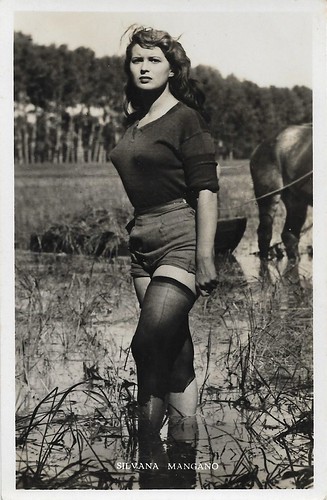
Belgian card offered by Nieuwe Merksemsche Chocolaterie SPRL, Merksem (Antwerp). Photo: Lux-Film, Roma. Silvana Mangano as the rice picker Silvana in Riso amaro/Bitter Rice (Giuseppe De Santis, 1949), released in Flanders and the Netherlands as Bittere Rijst.

French postcard by Ed. A. Noyer, Paris, no. 1256. Photo: Raymond Voinquel. Handsome and athletic Georges Marchal (1920-1997) was one of the main lead actors in the French cinema of the 1950s, together with Jean Marais.
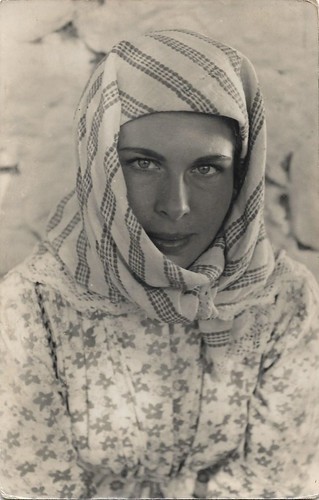
Austrian postcard. Photo: Cosmopol-Film, Wien. Barbara Rütting in Die letzte Brücke/The Last Bridge (Helmut Käutner, 1954).
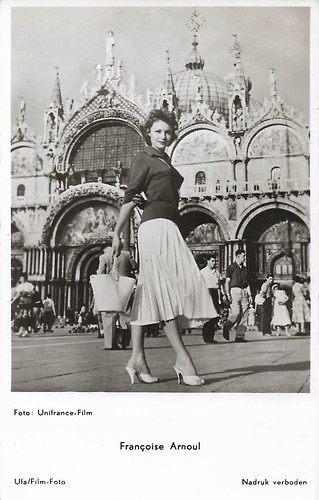
Belgian card by DRC, Holland, no. 1878. DRC was the licence folder for Ufa/ Film-Foto in Belgium. Photo: Unifrance-Film/Ufa/ Film-Foto. Françoise Arnoul in front of the St. Mark's Basilica in a time Venice was still dry.

French postcard by Croissant, Paris, no. 3890. Photo: Gaumont phot. Caption: Don José declares his love to Carmen. This card is probably for the 1906 film Carmen , directed by Alice Guy (-Blaché) for Gaumont. The film consisted of 12 so-called phonoscènes, an early sound-on-disc system. The second song/film scene was 'La fleur que tu m'avais jetée'. The film is presumed lost. Unknown is who the singers are. Croissant also released the coloured series of postcards for pre-1910 Pathé frères movies.

French publicity card. Drawing by Marthe Antoine Gérardin. Publicity for the play 'Chipee!' at the Théâtre de l'Avenue in Paris, a play in which Maud Loty also sang. Her co-actors were a.o. Jean Dax and Marguerite Moreno .

German postcard. Photo Becker & Maass, Berlin. As far as known, stage actress Charlotte Fraedrich only acted in one film, the short Der vertauschte Hund/The swapped dog (Kurt Bleines, 1937), but this postcard must date from the 1910s.

British postcard in the Cinema Stars series by Lilywhite Ltd., no. C.M. 19. Photo: Pathé. Fannie Ward's name is misspelled on this card.

French postcard by Cinémagazine-Edition, no. 189. Vanni Marcoux as Charles le Téméraire (Charles the Bold) in the French silent film Le Miracle des Loups (Raymond Bernard, 1924).

French postcard by JRPR, Paris, no. 301. Ernst / Edmond Van Duren in the French late silent film Figaro (Gaston Ravel, 1929), based on the play by Pierre Beaumarchais. Van Duren played the title role. Location shooting was done at the Château de Rochefort-sur-Yvelines.

Dutch postcard, no. 683. Photo: Metro Goldwyn Mayer. This photo could be related to Jeanette MacDonald's 1933 visit to the Netherlands.

Belgian postcard by Esclamator. Photo: Jan Vanderheyden-Film. Jef Bruyninckx in De Witte/Whitey (Jan Vanderheyden, 1934), based on the eponymous novel by Ernest Claes. In 1980 a new adaptation by Robbe De Hert would follow.

Dutch postcard, no. 610. Photo: Metro Goldwyn Mayer. In 1934 Gloria Swanson did a photo shoot involving this tiger rug and hairdo, before acting in the Jerome Kern musical Music in the air (Joe May, 1934). While some sources say the photos were made by Clarence Sinclair Bull, other sources silence the photographer.

British postcard in the Colourgraph Series, no. C248. Photo: Paramount. Henry Wilcoxon as King Richard in the period piece The Crusades (Cecil B. DeMille, 1935).

Belgian postcard by Film en Toneel, no. AX 141. Photo: Columbia Pictures. Joan Bennett pretending to read the Dutch-Flemish film magazine 'Film and Tooneel' (Film and Theatre). On the cover of the magazine is a still from Joan of Arc (Victor Fleming, 1948), featuring Ingrid Bergman .

Belgian card offered by Nieuwe Merksemsche Chocolaterie SPRL, Merksem (Antwerp). Photo: Lux-Film, Roma. Silvana Mangano as the rice picker Silvana in Riso amaro/Bitter Rice (Giuseppe De Santis, 1949), released in Flanders and the Netherlands as Bittere Rijst.

French postcard by Ed. A. Noyer, Paris, no. 1256. Photo: Raymond Voinquel. Handsome and athletic Georges Marchal (1920-1997) was one of the main lead actors in the French cinema of the 1950s, together with Jean Marais.

Austrian postcard. Photo: Cosmopol-Film, Wien. Barbara Rütting in Die letzte Brücke/The Last Bridge (Helmut Käutner, 1954).

Belgian card by DRC, Holland, no. 1878. DRC was the licence folder for Ufa/ Film-Foto in Belgium. Photo: Unifrance-Film/Ufa/ Film-Foto. Françoise Arnoul in front of the St. Mark's Basilica in a time Venice was still dry.
Published on November 17, 2019 22:00
November 16, 2019
Barbara Stanwyck
Barbara Stanwyck (1907-1990) was an American actress, model and dancer. She was a versatile professional with a strong, realistic screen presence. By 1944 Stanwyck had become the highest-paid woman in the United States. She was a favourite of her directors including Cecil B. DeMille, Fritz Lang, and Frank Capra. After a short but notable career as a stage actress in the late 1920s, she made 85 films in 38 years in Hollywood, before turning to television.

French postcard by Editions P.I., offered by Victoria S.A. (Biscuits, Chocolates and Patisserie), Brussels. Photo: Paramount Pictures 1950.

British Real Photograph postcard, London, no. FS 120. Photo: 20th Century Fox. Robert Taylor and Barbara Stanwyck in His Affair (William A. Seiter, 1937).

British postcard in the Picturegoer Series, no. W 68. Photo: Paramount.
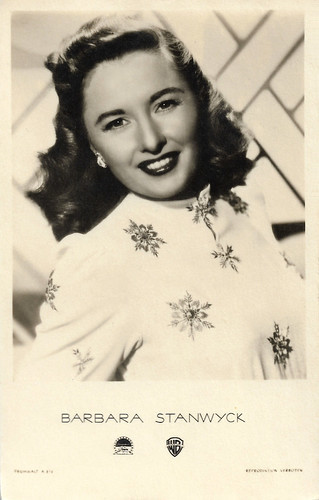
German postcard, no. 87. Photo: Paramount / Warner Bros.
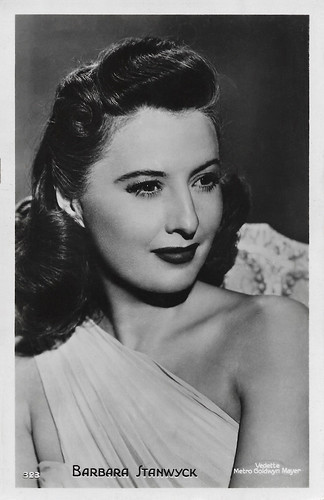
French postcard by Editions P.I., no. 323. Photo: Metro-Goldwyn-Mayer (MGM), 1953.
An extremely versatile actress who could adapt to any role
Barbara Stanwyck was born Ruby Catherine Stevens in 1907 in Brooklyn, New York. She was the daughter of Catherine Ann (McPhee) and Byron E. Stevens, a bricklayer.
Her mother died of complications from a miscarriage after she was accidentally knocked off a trolley by a drunk. Two weeks after the funeral, her father, Byron Stevens, joined a work crew digging the Panama Canal and was never seen again. Barbara was brought up by her elder sister Mildred and was partially raised in foster homes.
Ruby toured with her older sister Mildred during the summers of 1916 and 1917, and practiced her sister's routines backstage.
At the age of 14, she dropped out of school to take a job wrapping packages at a department store in Brooklyn. Later, she went to work at the local telephone company, but she had the urge to enter show business.
In 1923, a few months before her 16th birthday, Ruby auditioned for a place in the chorus at the Strand Roof, a nightclub over the Strand Theatre in Times Square. A few months later, she obtained a job as a dancer in the 1922 and 1923 seasons of the Ziegfeld Follies, dancing at the New Amsterdam Theater.
In 1926, she played a chorus girl in the play 'The Noose'. It became one of the most successful plays of the season, running on Broadway for nine months and 197 performances. Ruby changed her name to Barbara Stanwyck by combining the first name of her character, Barbara Frietchie, with the last name of another actress in the play, Jane Stanwyck.
Stanwyck became a Broadway star soon afterwards, when she was cast in her first leading role in 'Burlesque' (1927). She received rave reviews, and it was a huge hit. The producer had great plans for her, but the Hollywood offers kept coming.
In 1928 Barbara moved to Hollywood. Stanwyck's first sound film was The Locked Door (George Fitzmaurice, 1929) opposite Rod La Rocque, followed by Mexicali Rose (Erle C. Kenton, 1929). Neither film was successful. Nonetheless, Frank Capra chose Stanwyck for his romantic drama Ladies of Leisure (1930) with Ralph Graves, and it established an enduring friendship with the director. He would often choose her to be the star of his films.
Barbara Stanwyck soon proved to be an extremely versatile actress who could adapt to any role.
She was equally at home in all genres, from melodramas, such as Forbidden (Frank Capra, 1932) and Stella Dallas (King Vidor, 1937), to thrillers, such as Double Indemnity (Billy Wilder, 1944), also starring Fred MacMurray.
She was the ambitious woman sleeping her way to the top from 'the wrong side of the tracks' in Baby Face (Alfred E. Green, 1933), a pre-code classic. She also excelled in comedies such as Remember the Night (Mitchell Leisen, 1940) and The Lady Eve (Preston Sturges, 1941) opposite Henry Fonda, and in Westerns, such as Union Pacific (Cecil B. DeMille, 1939) with Joel McCrea.
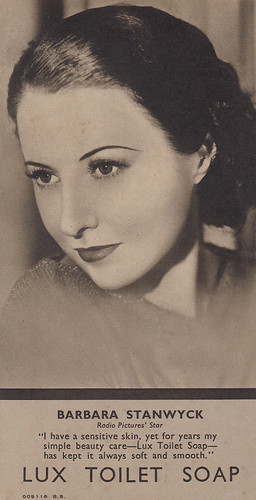
Vintage promotion card for Lux Toilet Soap. Collection: Marlene Pilaete.
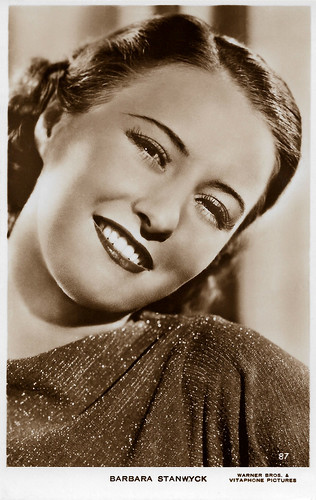
British postcard by Milton, no. 87. Photo: Warner Bros & Vitaphone Pictures.
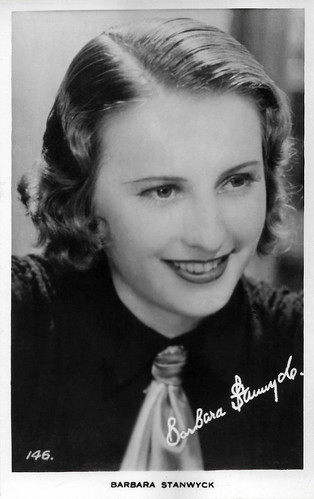
British postcard by Valentine & Sons LTD., Dundee and London, no. 146.
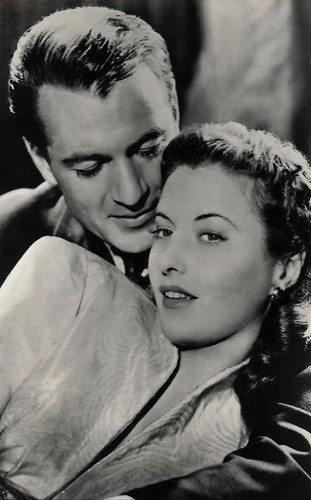
Spanish postcard by SOBE, no. 499. Sent by mail in 1949. Photo: Barbara Stanwyck and Gary Cooper in Ball of Fire (Howard Hawks, 1941).
Gay rumours
Barbara Stanwyck was also well known for her TV roles as Victoria, the matriarch of the Barkley family in the Western series The Big Valley (1965). In 1983, she also played in the hit mini-series The Thorn Birds (1983), which did much to keep her in the eye of the public. She turned in an outstanding performance as Mary Carson. One of her last roles was in the hit drama series The Colbys (1985).
She was nominated for the Academy Award for Best Actress four times, for Stella Dallas (King Vidor, 1937), Ball of Fire (Howard Hawks, 1941), Double Indemnity (Billy Wilder, 1944) and Sorry, Wrong Number ( Anatole Litvak, 1948).
For her television work, she won three Emmy Awards, for The Barbara Stanwyck Show (1961), The Big Valley (1966) and The Thorn Birds (1983). Her performance in The Thorn Birds also won her a Golden Globe. She received an Honorary Oscar at the 1982 Academy Award ceremony and the Golden Globe Cecil B. DeMille Award in 1986. She was also the recipient of honorary lifetime awards from the American Film Institute (1987), the Film Society of Lincoln Center (1986), the Los Angeles Film Critics Association (1981) and the Screen Actors Guild (1967).
Barbara Stanwyck died in 1990 in Santa Monica, Califonia. She was 82 and left 93 films and a host of TV appearances as her legacy. She was married twice, to film actors Frank Fay (1928-1935) and Robert Taylor (1939-1952). Her son, Dion Anthony 'Tony' Fay (1932) was adopted.
Frank Fay and Stanwyck's marriage and their experience in Hollywood is said to be the basis of the Hollywood film A Star is Born (William A. Wellman, 1937). The womanising, alcoholic Fay's career floundered, while Stanwyck's flourished for decades. Their stormy marriage finally ended after a drunken brawl, during which he tossed their adopted son, Dion, into the swimming pool.
Despite rumours of affairs with Marlene Dietrich and Joan Crawford, Stanwyck wed Robert Taylor, who had gay rumours of his own to dispel. Their marriage started off on a sour note when his possessive mother demanded he spend his wedding night with her rather than with Barbara.
In 1957 Tony, her adopted son, was arrested for trying to sell lewd pictures while waiting to cash his unemployment check. When questioned by the press about his famous mother, he replied, "We don't speak." They became permanently estranged in February 1951, when he was 19 years old. The rift never healed. She saw him only a few times after his childhood. He was reportedly bequeathed some money from Stanwyck's estate on condition he never speak publicly about her.
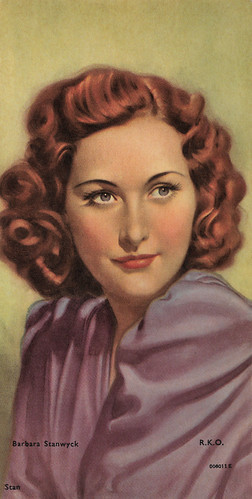
American postcard by Lux Soap, no. 008011E. Photo: R.K.O. Caption: Barbara Stanwyck, R.K.O. Star says: "Lux Toilet Soap's active lather leaves skin deliciously fragrant. It's the best way I know to protect daintiness!"
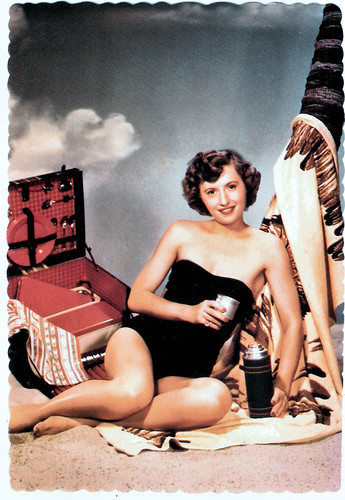
Canadian postcard by Fan Club Post Card, no. PC9.
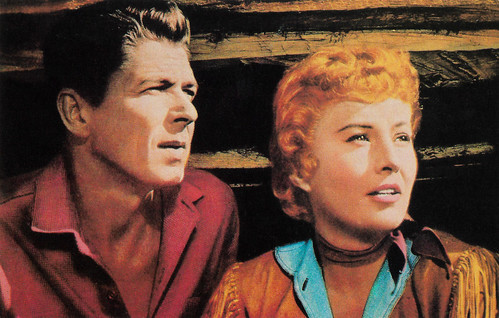
American postcard by Coral-Lee, Rancho Cordova, CA, no. SC17489. Photo: Tony Koroda / 1981 Sygma. Ronald Reagan and Barbara Stanwyck in Cattle Queen of Montana (Allan Dwan, 1954).
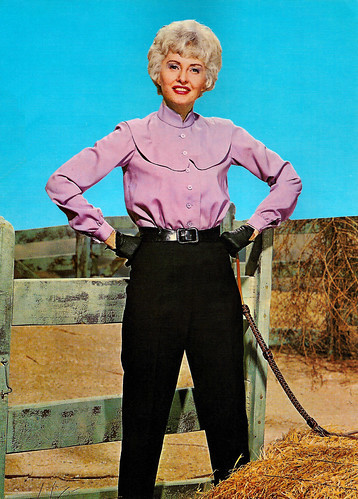
German postcard by Anco, no. 1/77. Photo: Four Star Margate. Barbara Stanwyck as Victoria Barkley in the TV series The Big Valley (1965).
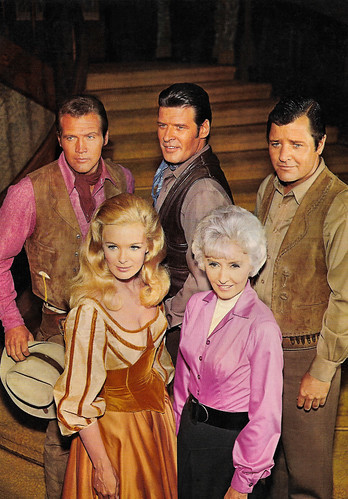
German postcard by Anco, no. 1/77. Photo: Four Star Margate. Barbara Stanwyck as Victoria Barkley, Linda Evans, Lee Majors, Richard Long and Peter Breck in the TV series The Big Valley (1965). Caption: Familie Barkley (Barkley Family).
Sources: (IMDb), Wikipedia and .

French postcard by Editions P.I., offered by Victoria S.A. (Biscuits, Chocolates and Patisserie), Brussels. Photo: Paramount Pictures 1950.

British Real Photograph postcard, London, no. FS 120. Photo: 20th Century Fox. Robert Taylor and Barbara Stanwyck in His Affair (William A. Seiter, 1937).

British postcard in the Picturegoer Series, no. W 68. Photo: Paramount.

German postcard, no. 87. Photo: Paramount / Warner Bros.

French postcard by Editions P.I., no. 323. Photo: Metro-Goldwyn-Mayer (MGM), 1953.
An extremely versatile actress who could adapt to any role
Barbara Stanwyck was born Ruby Catherine Stevens in 1907 in Brooklyn, New York. She was the daughter of Catherine Ann (McPhee) and Byron E. Stevens, a bricklayer.
Her mother died of complications from a miscarriage after she was accidentally knocked off a trolley by a drunk. Two weeks after the funeral, her father, Byron Stevens, joined a work crew digging the Panama Canal and was never seen again. Barbara was brought up by her elder sister Mildred and was partially raised in foster homes.
Ruby toured with her older sister Mildred during the summers of 1916 and 1917, and practiced her sister's routines backstage.
At the age of 14, she dropped out of school to take a job wrapping packages at a department store in Brooklyn. Later, she went to work at the local telephone company, but she had the urge to enter show business.
In 1923, a few months before her 16th birthday, Ruby auditioned for a place in the chorus at the Strand Roof, a nightclub over the Strand Theatre in Times Square. A few months later, she obtained a job as a dancer in the 1922 and 1923 seasons of the Ziegfeld Follies, dancing at the New Amsterdam Theater.
In 1926, she played a chorus girl in the play 'The Noose'. It became one of the most successful plays of the season, running on Broadway for nine months and 197 performances. Ruby changed her name to Barbara Stanwyck by combining the first name of her character, Barbara Frietchie, with the last name of another actress in the play, Jane Stanwyck.
Stanwyck became a Broadway star soon afterwards, when she was cast in her first leading role in 'Burlesque' (1927). She received rave reviews, and it was a huge hit. The producer had great plans for her, but the Hollywood offers kept coming.
In 1928 Barbara moved to Hollywood. Stanwyck's first sound film was The Locked Door (George Fitzmaurice, 1929) opposite Rod La Rocque, followed by Mexicali Rose (Erle C. Kenton, 1929). Neither film was successful. Nonetheless, Frank Capra chose Stanwyck for his romantic drama Ladies of Leisure (1930) with Ralph Graves, and it established an enduring friendship with the director. He would often choose her to be the star of his films.
Barbara Stanwyck soon proved to be an extremely versatile actress who could adapt to any role.
She was equally at home in all genres, from melodramas, such as Forbidden (Frank Capra, 1932) and Stella Dallas (King Vidor, 1937), to thrillers, such as Double Indemnity (Billy Wilder, 1944), also starring Fred MacMurray.
She was the ambitious woman sleeping her way to the top from 'the wrong side of the tracks' in Baby Face (Alfred E. Green, 1933), a pre-code classic. She also excelled in comedies such as Remember the Night (Mitchell Leisen, 1940) and The Lady Eve (Preston Sturges, 1941) opposite Henry Fonda, and in Westerns, such as Union Pacific (Cecil B. DeMille, 1939) with Joel McCrea.

Vintage promotion card for Lux Toilet Soap. Collection: Marlene Pilaete.

British postcard by Milton, no. 87. Photo: Warner Bros & Vitaphone Pictures.

British postcard by Valentine & Sons LTD., Dundee and London, no. 146.

Spanish postcard by SOBE, no. 499. Sent by mail in 1949. Photo: Barbara Stanwyck and Gary Cooper in Ball of Fire (Howard Hawks, 1941).
Gay rumours
Barbara Stanwyck was also well known for her TV roles as Victoria, the matriarch of the Barkley family in the Western series The Big Valley (1965). In 1983, she also played in the hit mini-series The Thorn Birds (1983), which did much to keep her in the eye of the public. She turned in an outstanding performance as Mary Carson. One of her last roles was in the hit drama series The Colbys (1985).
She was nominated for the Academy Award for Best Actress four times, for Stella Dallas (King Vidor, 1937), Ball of Fire (Howard Hawks, 1941), Double Indemnity (Billy Wilder, 1944) and Sorry, Wrong Number ( Anatole Litvak, 1948).
For her television work, she won three Emmy Awards, for The Barbara Stanwyck Show (1961), The Big Valley (1966) and The Thorn Birds (1983). Her performance in The Thorn Birds also won her a Golden Globe. She received an Honorary Oscar at the 1982 Academy Award ceremony and the Golden Globe Cecil B. DeMille Award in 1986. She was also the recipient of honorary lifetime awards from the American Film Institute (1987), the Film Society of Lincoln Center (1986), the Los Angeles Film Critics Association (1981) and the Screen Actors Guild (1967).
Barbara Stanwyck died in 1990 in Santa Monica, Califonia. She was 82 and left 93 films and a host of TV appearances as her legacy. She was married twice, to film actors Frank Fay (1928-1935) and Robert Taylor (1939-1952). Her son, Dion Anthony 'Tony' Fay (1932) was adopted.
Frank Fay and Stanwyck's marriage and their experience in Hollywood is said to be the basis of the Hollywood film A Star is Born (William A. Wellman, 1937). The womanising, alcoholic Fay's career floundered, while Stanwyck's flourished for decades. Their stormy marriage finally ended after a drunken brawl, during which he tossed their adopted son, Dion, into the swimming pool.
Despite rumours of affairs with Marlene Dietrich and Joan Crawford, Stanwyck wed Robert Taylor, who had gay rumours of his own to dispel. Their marriage started off on a sour note when his possessive mother demanded he spend his wedding night with her rather than with Barbara.
In 1957 Tony, her adopted son, was arrested for trying to sell lewd pictures while waiting to cash his unemployment check. When questioned by the press about his famous mother, he replied, "We don't speak." They became permanently estranged in February 1951, when he was 19 years old. The rift never healed. She saw him only a few times after his childhood. He was reportedly bequeathed some money from Stanwyck's estate on condition he never speak publicly about her.

American postcard by Lux Soap, no. 008011E. Photo: R.K.O. Caption: Barbara Stanwyck, R.K.O. Star says: "Lux Toilet Soap's active lather leaves skin deliciously fragrant. It's the best way I know to protect daintiness!"

Canadian postcard by Fan Club Post Card, no. PC9.

American postcard by Coral-Lee, Rancho Cordova, CA, no. SC17489. Photo: Tony Koroda / 1981 Sygma. Ronald Reagan and Barbara Stanwyck in Cattle Queen of Montana (Allan Dwan, 1954).

German postcard by Anco, no. 1/77. Photo: Four Star Margate. Barbara Stanwyck as Victoria Barkley in the TV series The Big Valley (1965).

German postcard by Anco, no. 1/77. Photo: Four Star Margate. Barbara Stanwyck as Victoria Barkley, Linda Evans, Lee Majors, Richard Long and Peter Breck in the TV series The Big Valley (1965). Caption: Familie Barkley (Barkley Family).
Sources: (IMDb), Wikipedia and .
Published on November 16, 2019 22:00
November 15, 2019
New acquisitions: Les Vedettes du Cinéma
Two years ago, EFSP did a post on the Les Vedettes du Cinéma series, published by the French publishing house Éditions Filma shortly after the First World War. Then we focused on the postcards with French 'vedettes'. Recently we acquired some new postcards of this vintage series, which is larger than we thought in 2017. Instead of the 70 cards we mentioned in the old post, the series contains at least 90 postcards. Today, 15 postcards with both European and American stars.
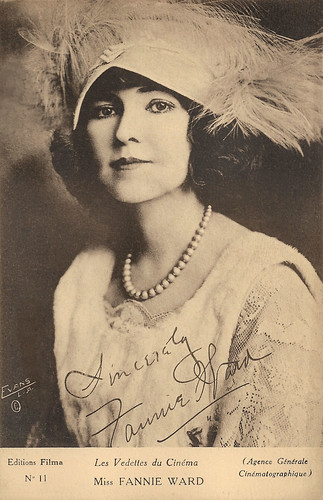
French postcard in the Les Vedettes du Cinéma series by Filma, no. 11. Photo: Evans, L.A. / Agence Générale Cinematographique.
Fannie Ward, a.k.a. Fanny Ward (1872–1952) was an American actress of stage and screen, known for The Cheat (1915), a sexually- and racially-charged silent film directed by Cecil B. DeMille. In the late 1910s, she did a series of films for Astra Films, released by Pathé Exchange.
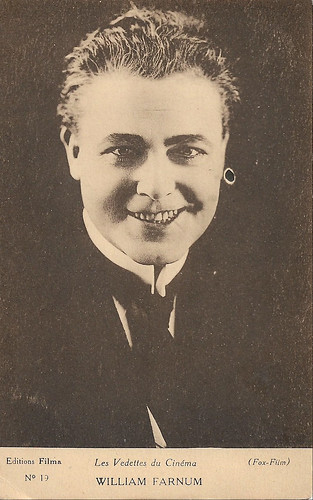
French postcard in the Les Vedettes du Cinéma series by Filma, no. 19. Photo: Fox-Film.
American actor William Farnum (1876-1953) was one of the first major movie stars. From 1914 to 1925, Farnum was one of the biggest sensations in Hollywood, earning $10,000 a week. Farnum's silent pictures include the Westerns The Spoilers (1914) - which culminates in a spectacular saloon fistfight, Drag Harlan (1920) and the drama-adventure If I Were King (1921).

French postcard in the Les Vedettes du Cinéma series by Editions Filma, no. 24.
Georges Melchior (1889-1944) was a French film actor, active in French cinema between 1911 and 1937. He was known for the Fantômas serials (1913-1914) by Louis Feuillade, and L'Atlantide (1921).
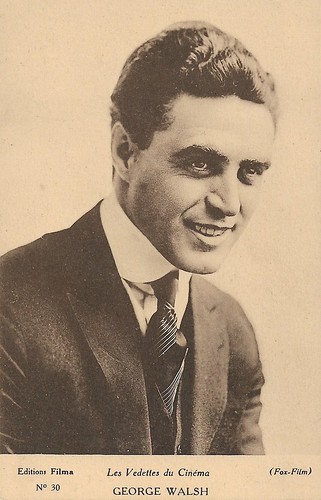
French postcard in the Les Vedettes du Cinéma series by Editions Filma, no. 30. Photo: Fox-Film.
George Walsh (1889-1981) was an American film actor, who despite a successful career in silent cinema is best remembered for the part that was taken off from him: the title role in Ben-Hur (1925).
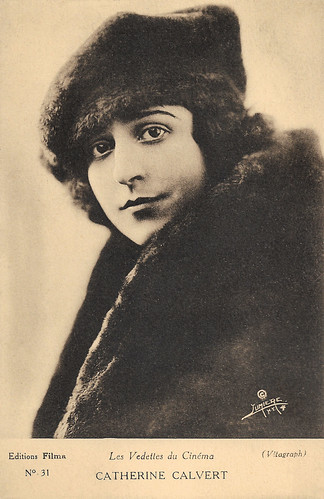
French postcard in the Les Vedettes du Cinéma series by Editions Filma, no. 31. Photo: Lumiere, New York / Vitagraph.
Catherine Calvert (1890–1971) was an American actress. After many years on the stage, and after the death in 1915 of her husband, the playwright Paul Armstrong, she made her film debut in the Universal film production Partners (Hobart Hanley, 1916). In the following years, she often worked under the direction of James Kirkwood for Frank A. Keeney Pictures, e.g. in A Romance of the Underworld (James Kirkwood, 1918). Around 1920 Calvert was a star of the Vitagraph Studios in films like Dead Men Tell No Tales (Tom Terriss, 1920). In 1923 she did her last film: Out to Win (James Kirkwood, 1923). In 1925 she married her second husband, millionnaire George Carrothers, a Canadian wheat exporter. All in all, she acted in 21 films.
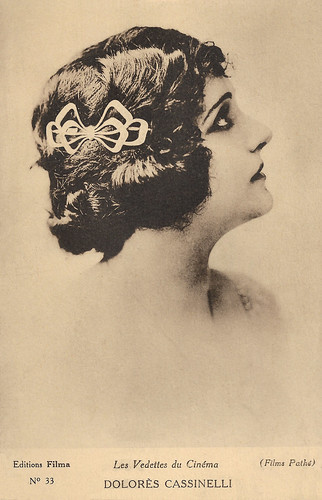
French postcard in the Les Vedettes du Cinéma series by Editions Filma, no. 33. Photo: Films Pathé.
Dolores Cassinelli (1888-1984) was an American actress. She was dubbed 'The Cameo Girl of the Movies'. From 1911 to 1925, when she retired from the screens, Dolores Cassinelli acted in about eighty films.
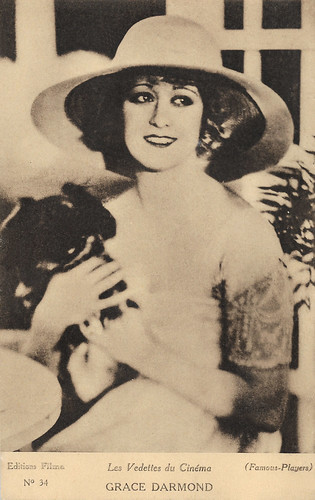
French postcard in the Les Vedettes du Cinéma series by Editions Filma, no. 34. Photo: Famous Players.
Grace Darmond (1893-1963) was a Canadian-American actress of the silent screen. In 1918 or 1919 Darmond started to work in California at various studios, first at Famous Players for The Valley of the Giants (James Cruze, 1919), with Wallace Reid. Her performance as the seductress in the Thomas Ince production Below the Surface (Irvin Willat, 1920), alongside Hobart Bosworth and Lloyd Hughes as a deep-sea diver and his son, earned her in 1921 the chance to play opposite Boris Karloff (his first feature part) in the serial The Hope Diamond Mystery (dir. Stuart Paton).
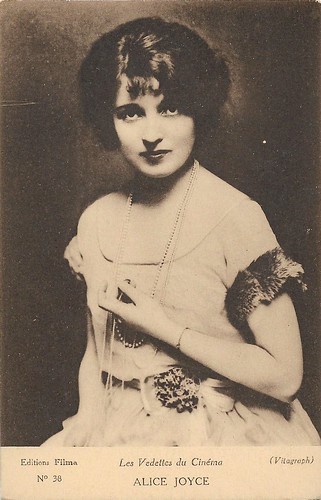
French postcard in the Les Vedettes du Cinéma series by Editions Filma, no. 38. Photo: Vitagraph.
Alice Joyce (1890-1955) was an American screen actress, who, at the peak of her career, was nicknamed 'the Madonna of the Screen'.
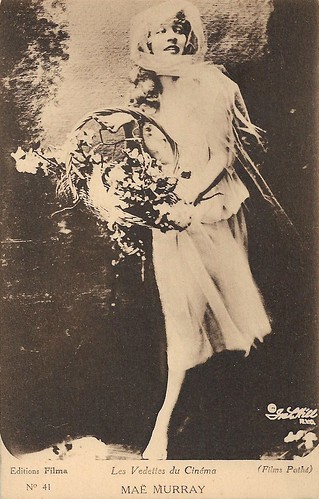
French postcard in the Les Vedettes du Cinéma series by Editions Filma, no. 41. Photo: John Hill / Films Pathé.
American actress and dancer Mae Murray (1885-1965) had her breakthrough on Broadway at the Ziegfeld Follies. Her film debut was in To Have and to Hold (1916). Murray became one of the biggest stars of Universal, often directed by her then-husband, Robert Z. Leonard. At the height of her career, she decided to found her own company with director John Stahl. While the films were successful, critics didn’t like them, because of her exaggerated emotions and her costumes. In the early 1920s, Murray started acting at Metro (later MGM). Murray’s most famous role was that in Erich Von Stroheim’s The Merry Widow (1925), co-starring John Gilbert.
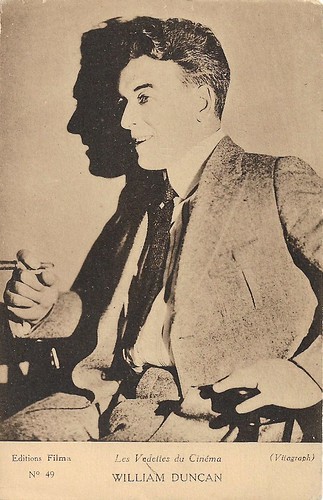
French postcard in the Les Vedettes du Cinéma series by Editions Filma, no. 49. Photo: Vitagraph.
William Duncan (1879–1961), born in Dundee, Scotland was an actor, writer, and director of films and film serials, often Westerns. He was a leading star, becoming one of the highest-paid actors in the early film industry, though many of his films do not survive. Duncan, who was Hollywood's first Scottish movie star, worked with the major studios of the day including the Selig Polyscope Company and Vitagraph.
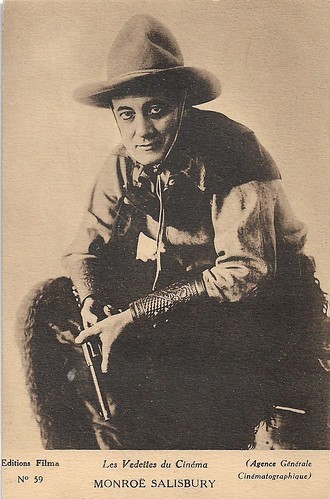
French postcard in the Les Vedettes du Cinéma series by Editions Filma, no. 59. Photo: Agence Générale Cinématographique.
Monroe Salisbury (1876-1935) was an American stage and screen actor, who peaked on screen in the late 1910s and early 1920s, often in Westerns.
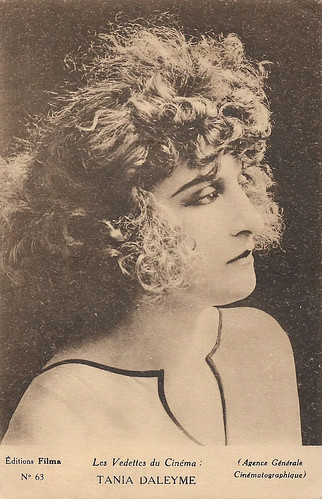
French postcard in the Les Vedettes du Cinéma series by Filma, no. 63. Photo: Agence Générale Cinématographique.
Though no details are known about the life dates and private life of French actress Tania Daleyme, she is famous for her lead in one film by Germaine Dulac, La belle dame sans merci (1920), while she had a supporting role as a bar maid in Dulac's experimental film L'invitation au voyage (1927). She also had supporting parts in Simplette (René Hervil, 1919), Tristan et Yseult (Maurice Mariaud, 1920), Le coeur magnifique (Jean Legrand, Séverin-Mars, 1921), Le double (Alexander Ryder, 1923), and Titi premier, roi des gosses (René Leprince, 1926).
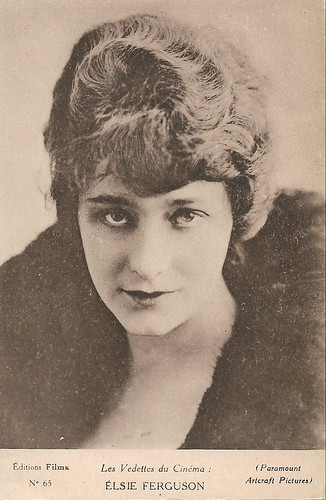
French postcard in the Les Vedettes du Cinéma series by Editions Filma, no. 65. Photo: Paramount Artcraft Pictures.
Elsie Ferguson (1885–1961) was an American stage and film actress. She first climbed up to become a big Broadway star thanks to producers such as Charles Frohman and Henry B. Harris, who both perished in the sinking of resp. the Lusitania and the Titanic. After her Broadway career, she had a fertile career in the silent cinema, from 1917 till 1922. She debuted in Maurice Tourneur's Barbary Sheep (1917). Playing often elegant society women, but also because of her arrogant behaviour, she was nicknamed 'the Aristocrat of the Screen'.
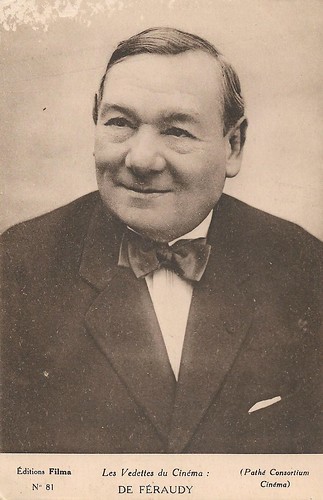
French postcard in the Les Vedettes du Cinéma series by Editions Filma, no. 81. Photo: Pathé Consortium Cinéma.
Maurice de Féraudy (1859-1932) was an actor of the Comédie-Française and a French director. He was also a notable actor and director in the French silent cinema. One of his most remarkable parts was that of the title role in the realist drama Crainquebille/Bill/Old Bill of Paris (Jacques Feyder, 1922).
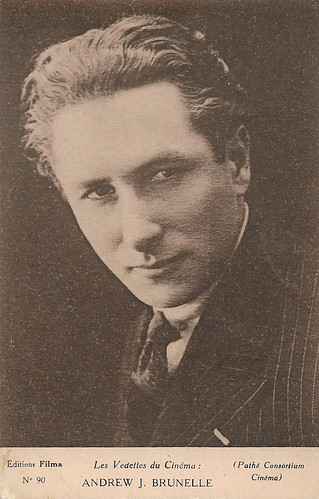
French postcard in the Les Vedettes du Cinéma series by Filma, no. 90. Photo: Pathé Consortium Cinéma.
Andrew Brunelle (1894-1943) was a French screen actor of the silent and sound era. He played Dr. Howey in Louis Feuillade's serial La nouvelle mission de Judex (1917), starring René Cresté as Judex. Brunelle played an evil doctor, member of the dangerous gang La rafle aux secrets (the raiders of the secrets), who avid to steal and resell important technological inventions.

French postcard in the Les Vedettes du Cinéma series by Filma, no. 11. Photo: Evans, L.A. / Agence Générale Cinematographique.
Fannie Ward, a.k.a. Fanny Ward (1872–1952) was an American actress of stage and screen, known for The Cheat (1915), a sexually- and racially-charged silent film directed by Cecil B. DeMille. In the late 1910s, she did a series of films for Astra Films, released by Pathé Exchange.

French postcard in the Les Vedettes du Cinéma series by Filma, no. 19. Photo: Fox-Film.
American actor William Farnum (1876-1953) was one of the first major movie stars. From 1914 to 1925, Farnum was one of the biggest sensations in Hollywood, earning $10,000 a week. Farnum's silent pictures include the Westerns The Spoilers (1914) - which culminates in a spectacular saloon fistfight, Drag Harlan (1920) and the drama-adventure If I Were King (1921).

French postcard in the Les Vedettes du Cinéma series by Editions Filma, no. 24.
Georges Melchior (1889-1944) was a French film actor, active in French cinema between 1911 and 1937. He was known for the Fantômas serials (1913-1914) by Louis Feuillade, and L'Atlantide (1921).

French postcard in the Les Vedettes du Cinéma series by Editions Filma, no. 30. Photo: Fox-Film.
George Walsh (1889-1981) was an American film actor, who despite a successful career in silent cinema is best remembered for the part that was taken off from him: the title role in Ben-Hur (1925).

French postcard in the Les Vedettes du Cinéma series by Editions Filma, no. 31. Photo: Lumiere, New York / Vitagraph.
Catherine Calvert (1890–1971) was an American actress. After many years on the stage, and after the death in 1915 of her husband, the playwright Paul Armstrong, she made her film debut in the Universal film production Partners (Hobart Hanley, 1916). In the following years, she often worked under the direction of James Kirkwood for Frank A. Keeney Pictures, e.g. in A Romance of the Underworld (James Kirkwood, 1918). Around 1920 Calvert was a star of the Vitagraph Studios in films like Dead Men Tell No Tales (Tom Terriss, 1920). In 1923 she did her last film: Out to Win (James Kirkwood, 1923). In 1925 she married her second husband, millionnaire George Carrothers, a Canadian wheat exporter. All in all, she acted in 21 films.

French postcard in the Les Vedettes du Cinéma series by Editions Filma, no. 33. Photo: Films Pathé.
Dolores Cassinelli (1888-1984) was an American actress. She was dubbed 'The Cameo Girl of the Movies'. From 1911 to 1925, when she retired from the screens, Dolores Cassinelli acted in about eighty films.

French postcard in the Les Vedettes du Cinéma series by Editions Filma, no. 34. Photo: Famous Players.
Grace Darmond (1893-1963) was a Canadian-American actress of the silent screen. In 1918 or 1919 Darmond started to work in California at various studios, first at Famous Players for The Valley of the Giants (James Cruze, 1919), with Wallace Reid. Her performance as the seductress in the Thomas Ince production Below the Surface (Irvin Willat, 1920), alongside Hobart Bosworth and Lloyd Hughes as a deep-sea diver and his son, earned her in 1921 the chance to play opposite Boris Karloff (his first feature part) in the serial The Hope Diamond Mystery (dir. Stuart Paton).

French postcard in the Les Vedettes du Cinéma series by Editions Filma, no. 38. Photo: Vitagraph.
Alice Joyce (1890-1955) was an American screen actress, who, at the peak of her career, was nicknamed 'the Madonna of the Screen'.

French postcard in the Les Vedettes du Cinéma series by Editions Filma, no. 41. Photo: John Hill / Films Pathé.
American actress and dancer Mae Murray (1885-1965) had her breakthrough on Broadway at the Ziegfeld Follies. Her film debut was in To Have and to Hold (1916). Murray became one of the biggest stars of Universal, often directed by her then-husband, Robert Z. Leonard. At the height of her career, she decided to found her own company with director John Stahl. While the films were successful, critics didn’t like them, because of her exaggerated emotions and her costumes. In the early 1920s, Murray started acting at Metro (later MGM). Murray’s most famous role was that in Erich Von Stroheim’s The Merry Widow (1925), co-starring John Gilbert.

French postcard in the Les Vedettes du Cinéma series by Editions Filma, no. 49. Photo: Vitagraph.
William Duncan (1879–1961), born in Dundee, Scotland was an actor, writer, and director of films and film serials, often Westerns. He was a leading star, becoming one of the highest-paid actors in the early film industry, though many of his films do not survive. Duncan, who was Hollywood's first Scottish movie star, worked with the major studios of the day including the Selig Polyscope Company and Vitagraph.

French postcard in the Les Vedettes du Cinéma series by Editions Filma, no. 59. Photo: Agence Générale Cinématographique.
Monroe Salisbury (1876-1935) was an American stage and screen actor, who peaked on screen in the late 1910s and early 1920s, often in Westerns.

French postcard in the Les Vedettes du Cinéma series by Filma, no. 63. Photo: Agence Générale Cinématographique.
Though no details are known about the life dates and private life of French actress Tania Daleyme, she is famous for her lead in one film by Germaine Dulac, La belle dame sans merci (1920), while she had a supporting role as a bar maid in Dulac's experimental film L'invitation au voyage (1927). She also had supporting parts in Simplette (René Hervil, 1919), Tristan et Yseult (Maurice Mariaud, 1920), Le coeur magnifique (Jean Legrand, Séverin-Mars, 1921), Le double (Alexander Ryder, 1923), and Titi premier, roi des gosses (René Leprince, 1926).

French postcard in the Les Vedettes du Cinéma series by Editions Filma, no. 65. Photo: Paramount Artcraft Pictures.
Elsie Ferguson (1885–1961) was an American stage and film actress. She first climbed up to become a big Broadway star thanks to producers such as Charles Frohman and Henry B. Harris, who both perished in the sinking of resp. the Lusitania and the Titanic. After her Broadway career, she had a fertile career in the silent cinema, from 1917 till 1922. She debuted in Maurice Tourneur's Barbary Sheep (1917). Playing often elegant society women, but also because of her arrogant behaviour, she was nicknamed 'the Aristocrat of the Screen'.

French postcard in the Les Vedettes du Cinéma series by Editions Filma, no. 81. Photo: Pathé Consortium Cinéma.
Maurice de Féraudy (1859-1932) was an actor of the Comédie-Française and a French director. He was also a notable actor and director in the French silent cinema. One of his most remarkable parts was that of the title role in the realist drama Crainquebille/Bill/Old Bill of Paris (Jacques Feyder, 1922).

French postcard in the Les Vedettes du Cinéma series by Filma, no. 90. Photo: Pathé Consortium Cinéma.
Andrew Brunelle (1894-1943) was a French screen actor of the silent and sound era. He played Dr. Howey in Louis Feuillade's serial La nouvelle mission de Judex (1917), starring René Cresté as Judex. Brunelle played an evil doctor, member of the dangerous gang La rafle aux secrets (the raiders of the secrets), who avid to steal and resell important technological inventions.
Published on November 15, 2019 22:00
November 14, 2019
Roy Rogers
American singer and cowboy actor Roy Rogers (1911–1998) was one of the most popular Western stars of his era. Known as the 'King of the Cowboys', he appeared in over 100 films, mostly for Republic Pictures.
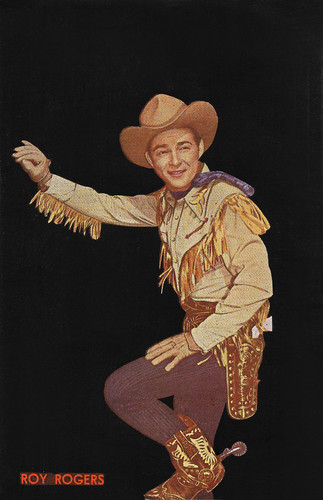
Dutch postcard. Sent by mail in 1952.
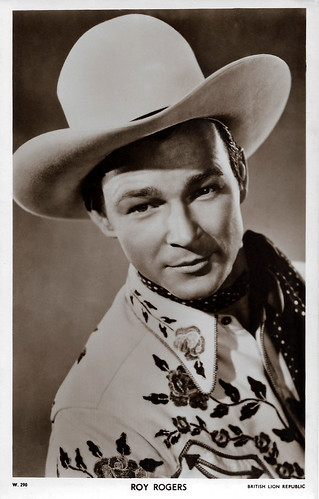
British postcard in the Picturegoer Series, London, no. W 290. Photo: British Lion Republic.
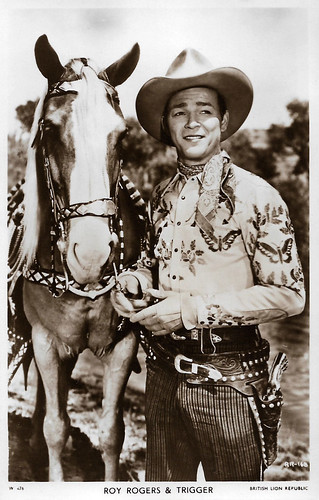
British postcard in the Picturegoer Series, London, no. W 476. Photo: British Lion / Republic Pictures.
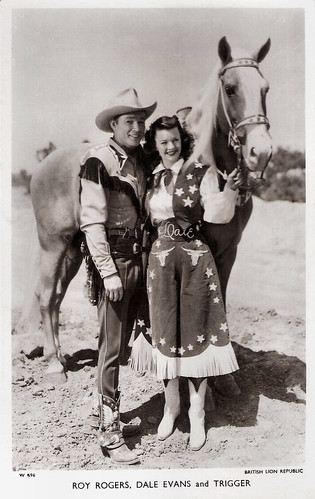
Roy Rogers, Dale Evans and Trigger. British postcard in the Picturegoer Series, London, no. W. 596. Photo: British Lion Republic.
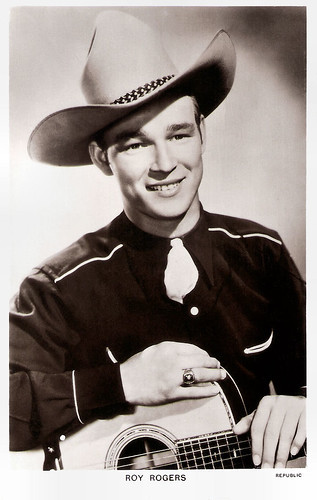
British postcard in the Picturegoer Series, London, no. 1389. Photo: Republic Pictures.
A matinee idol and an American legend
Roy Rogers was born Leonard Slye in 1911 in Cincinnati, Ohio, USA. He was the son of Mattie (née Womack) and Andrew Slye.
Later, living on a farm near Lucasville with no radio, the family made their own entertainment. On Saturday nights, they often invited neighbours over for square dances, during which Len would sing, play mandolin, and call the square dances. He also learned to yodel during this time, and his mother and he would use different yodels to communicate with each other across distances on the farm.
By 1929, after his older sister Mary and her husband had moved to Lawndale, California, Len and his father quit their factory jobs, packed up their 1923 Dodge, and drove the family to California to visit Mary. He moved definitively to California in 1930, aged 18. He played in such musical groups as The Hollywood Hillbillies, Rocky Mountaineers, Texas Outlaws, and his own group, the International Cowboys.
In 1934 he formed a group with Bob Nolan called Sons of the Pioneers. By the summer of 1934, the popularity and fame of the Sons of the Pioneers extended beyond the Los Angeles area and quickly spread across the country through short syndicated radio segments that were later rebroadcast across the United States. The Sons of the Pioneers signed a recording contract with the newly founded Decca label and made their first commercial recording in August 1934.
While in that group he was known as Leonard Slye, then as Dick Weston. Their songs included 'Cool Water' and 'Tumbling Tumbleweeds'. They first appeared in the western Rhythm on the Range (Norman Taurog, 1936), starring Bing Crosby, Frances Farmer and Martha Raye.
From his first film appearance, he appeared steadily in Westerns, including a bit role as a bandit opposite Gene Autry in The Old Coral (Joseph Kane, 1936). In 1937 he went solo from Sons Of The Pioneers.
In 1938, he played a large supporting role as a singing cowboy in another Gene Autry Western, The Old Barn Dance (Joseph Kane, 1938). That same year, Autry entered the United States Army Air Force. Republic immediately rechristened Slye 'Roy Rogers', and he was assigned the lead in Under Western Stars (Joseph Kane, 1938) with Smiley Burnette and Carol Hughes. In the film, Roy is elected to Congress to bring the misery of the 'dustbowl' of the 1930s to the attention of Washington politicians.
Rogers became a matinee idol and an American legend. In addition to his own films, Rogers played a supporting role in the John Wayne classic Dark Command (Raoul Walsh, 1940). In the Motion Picture Herald Top Ten Money-Making Western Stars poll, Rogers was listed for 15 consecutive years from 1939 to 1954, holding first place from 1943 to 1954.
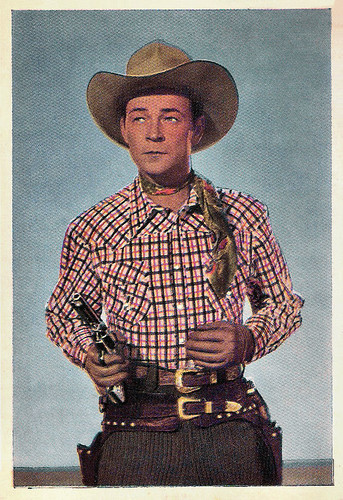
Belgian postcard, no. KF 2. Photo: Republic Pictures.
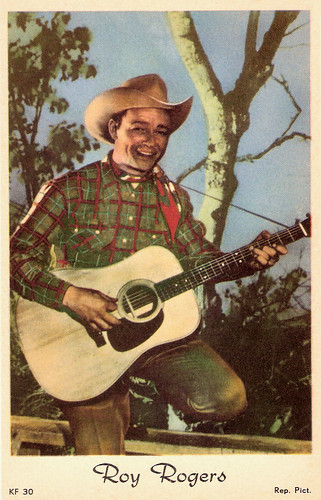
Belgian postcard, no. KF 30. Photo: Republic Pictures.
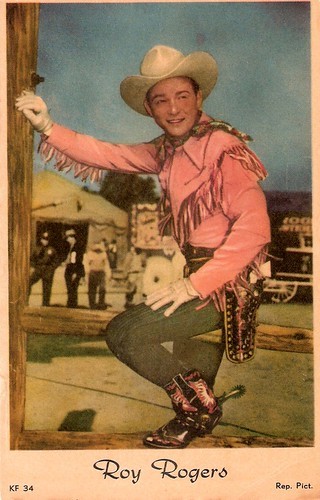
Belgian postcard, no. KF 34. Photo: Republic Pictures.
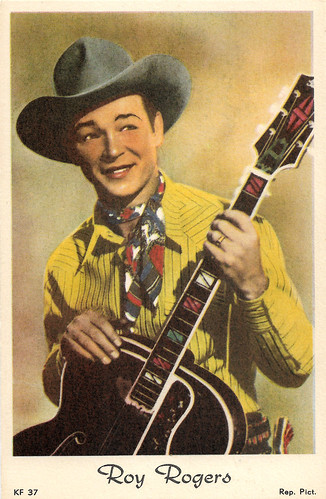
Belgian postcard, no. KF 37. Photo: Republic Pictures.
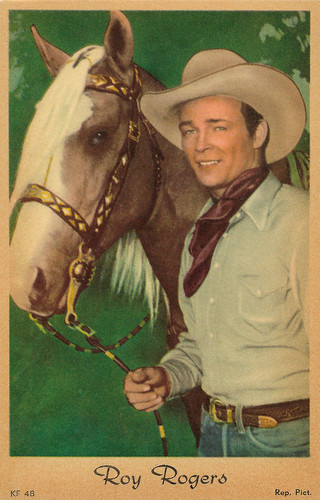
Belgian postcard, no. KF 48. Photo: Republic Pictures.
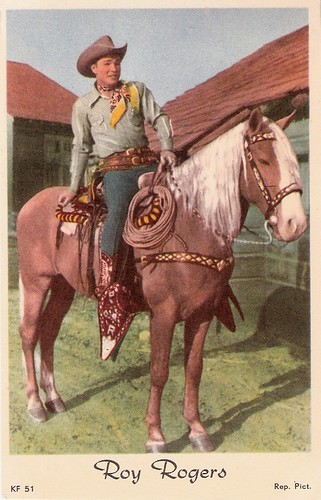
Belgian postcard, no. KF 51. Photo: Republic Pictures.
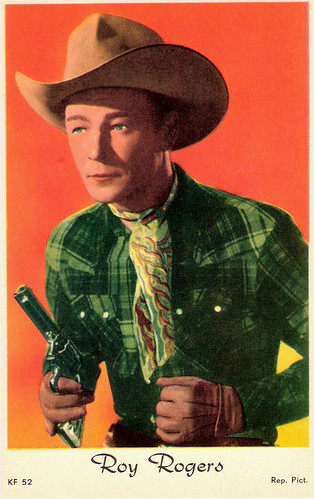
Belgian postcard, no. KF 52. Photo: Republic Pictures.
Happy trails
Roy Rogers also did numerous radio and television episodes of The Roy Rogers Show. In many of his films and television episodes, he appeared with his wife Dale Evans, his golden palomino Trigger, and his German Shepherd dog Bullet. Roy's theme song, 'Happy Trails', was written by Dale Evans.
His show ran on radio for nine years before moving to television from 1951 through 1957. His productions usually featured a sidekick, often Pat Brady, Andy Devine, or George 'Gabby' Hayes.
In 1965 his horse Trigger died at age 33. Roy got his horse in 1938 and rode him in every one of his films and TV shows after that. Trigger had appeared in one earlier film, ridden by Olivia de Havilland in The Adventures of Robin Hood (Michael Curtiz, 1938).
In his later years, Rogers lent his name to the Roy Rogers Restaurants franchised chain. His final film part was as an old time working cowboy who's not settled down in Mackintosh and T.J. (Marvin J. Chomsky, 1975). He was elected to the Country Music Hall of Fame in 1980 as a member of the Sons of the Pioneers and elected again in 1988 as Roy Rogers.
Roy Rogers died in 1998 in Apple Valley, California, USA, of congestive heart failure. He was married three times. He married his first wife Lucile Ascolese in 1933 and they divorced in 1936.
That year he married Grace Arline Wilkins. While performing in Roswell, New Mexico, a caller to a radio station ( Grace Arline Wilkins) promised Rogers that she would bake him a pie if he sang 'The Swiss Yodel'. Romance blossomed, and the couple married in Roswell in 1936. They had three children, but she died in 1946, a few days after giving birth to their son, Roy Rogers Jr. (Dusty). She had complications from the cesarean - a blood clot formed, travelled to her brain and killed her.
A year later he married Dale Evans, with whom he had six children. They remained together till his death. There was a Roy Rogers & Dale Evans Museum at Branson, Missouri, but it closed in 2011. All the memorabilia were sold at an auction in April and May of 2011
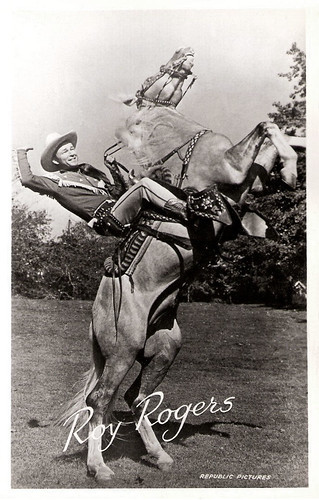
Dutch postcard. Photo: Republic Pictures.
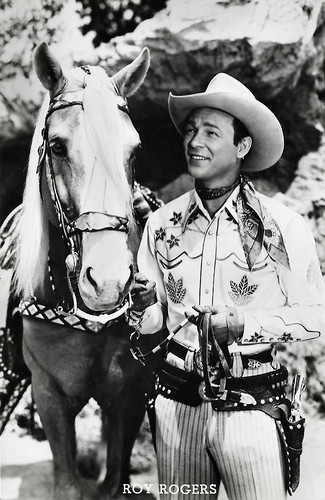
Belgian postcard. Photo: Republic Pictures.
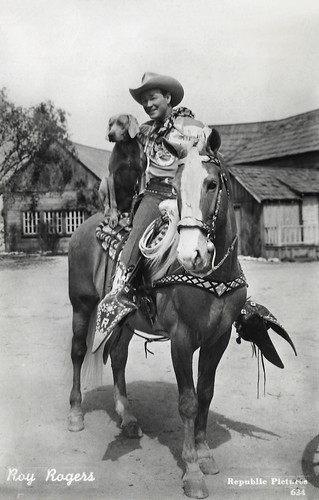
Dutch postcard by Filmphoto Service, Amsterdam, no. 634. Photo: Republic Pictures.
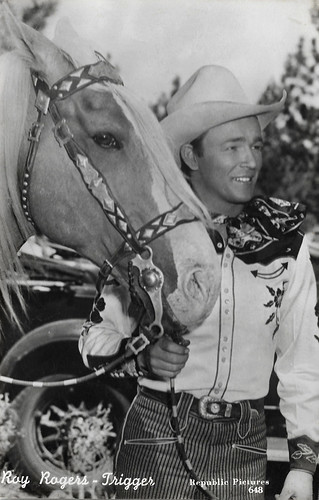
Dutch postcard by Filmphoto Service, Amsterdam, no. 648. Photo: Republic Pictures.
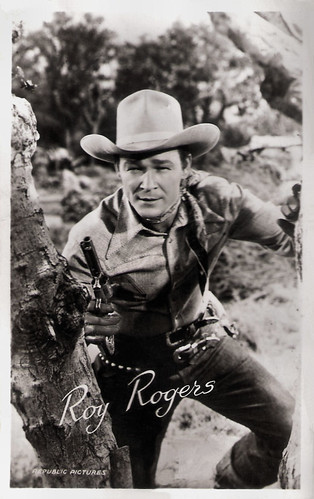
Belgian postcard. Photo: Republic Pictures.
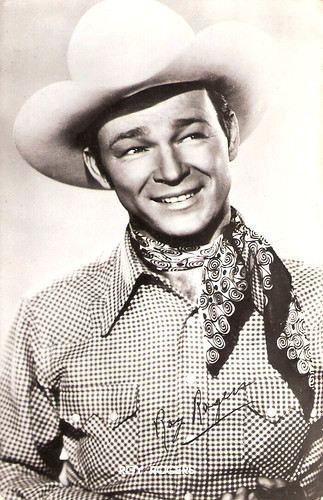
Dutch postcard, no. 150.
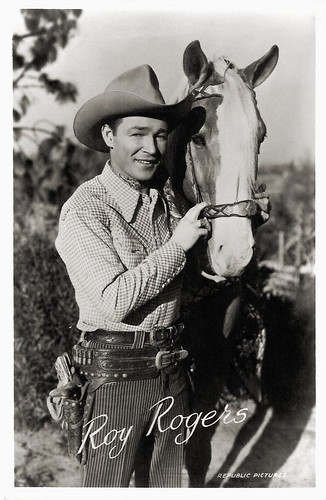
Dutch postcard. Photo: Republic Pictures.
Sources: (IMDb), Wikipedia and .

Dutch postcard. Sent by mail in 1952.

British postcard in the Picturegoer Series, London, no. W 290. Photo: British Lion Republic.

British postcard in the Picturegoer Series, London, no. W 476. Photo: British Lion / Republic Pictures.

Roy Rogers, Dale Evans and Trigger. British postcard in the Picturegoer Series, London, no. W. 596. Photo: British Lion Republic.

British postcard in the Picturegoer Series, London, no. 1389. Photo: Republic Pictures.
A matinee idol and an American legend
Roy Rogers was born Leonard Slye in 1911 in Cincinnati, Ohio, USA. He was the son of Mattie (née Womack) and Andrew Slye.
Later, living on a farm near Lucasville with no radio, the family made their own entertainment. On Saturday nights, they often invited neighbours over for square dances, during which Len would sing, play mandolin, and call the square dances. He also learned to yodel during this time, and his mother and he would use different yodels to communicate with each other across distances on the farm.
By 1929, after his older sister Mary and her husband had moved to Lawndale, California, Len and his father quit their factory jobs, packed up their 1923 Dodge, and drove the family to California to visit Mary. He moved definitively to California in 1930, aged 18. He played in such musical groups as The Hollywood Hillbillies, Rocky Mountaineers, Texas Outlaws, and his own group, the International Cowboys.
In 1934 he formed a group with Bob Nolan called Sons of the Pioneers. By the summer of 1934, the popularity and fame of the Sons of the Pioneers extended beyond the Los Angeles area and quickly spread across the country through short syndicated radio segments that were later rebroadcast across the United States. The Sons of the Pioneers signed a recording contract with the newly founded Decca label and made their first commercial recording in August 1934.
While in that group he was known as Leonard Slye, then as Dick Weston. Their songs included 'Cool Water' and 'Tumbling Tumbleweeds'. They first appeared in the western Rhythm on the Range (Norman Taurog, 1936), starring Bing Crosby, Frances Farmer and Martha Raye.
From his first film appearance, he appeared steadily in Westerns, including a bit role as a bandit opposite Gene Autry in The Old Coral (Joseph Kane, 1936). In 1937 he went solo from Sons Of The Pioneers.
In 1938, he played a large supporting role as a singing cowboy in another Gene Autry Western, The Old Barn Dance (Joseph Kane, 1938). That same year, Autry entered the United States Army Air Force. Republic immediately rechristened Slye 'Roy Rogers', and he was assigned the lead in Under Western Stars (Joseph Kane, 1938) with Smiley Burnette and Carol Hughes. In the film, Roy is elected to Congress to bring the misery of the 'dustbowl' of the 1930s to the attention of Washington politicians.
Rogers became a matinee idol and an American legend. In addition to his own films, Rogers played a supporting role in the John Wayne classic Dark Command (Raoul Walsh, 1940). In the Motion Picture Herald Top Ten Money-Making Western Stars poll, Rogers was listed for 15 consecutive years from 1939 to 1954, holding first place from 1943 to 1954.

Belgian postcard, no. KF 2. Photo: Republic Pictures.

Belgian postcard, no. KF 30. Photo: Republic Pictures.

Belgian postcard, no. KF 34. Photo: Republic Pictures.

Belgian postcard, no. KF 37. Photo: Republic Pictures.

Belgian postcard, no. KF 48. Photo: Republic Pictures.

Belgian postcard, no. KF 51. Photo: Republic Pictures.

Belgian postcard, no. KF 52. Photo: Republic Pictures.
Happy trails
Roy Rogers also did numerous radio and television episodes of The Roy Rogers Show. In many of his films and television episodes, he appeared with his wife Dale Evans, his golden palomino Trigger, and his German Shepherd dog Bullet. Roy's theme song, 'Happy Trails', was written by Dale Evans.
His show ran on radio for nine years before moving to television from 1951 through 1957. His productions usually featured a sidekick, often Pat Brady, Andy Devine, or George 'Gabby' Hayes.
In 1965 his horse Trigger died at age 33. Roy got his horse in 1938 and rode him in every one of his films and TV shows after that. Trigger had appeared in one earlier film, ridden by Olivia de Havilland in The Adventures of Robin Hood (Michael Curtiz, 1938).
In his later years, Rogers lent his name to the Roy Rogers Restaurants franchised chain. His final film part was as an old time working cowboy who's not settled down in Mackintosh and T.J. (Marvin J. Chomsky, 1975). He was elected to the Country Music Hall of Fame in 1980 as a member of the Sons of the Pioneers and elected again in 1988 as Roy Rogers.
Roy Rogers died in 1998 in Apple Valley, California, USA, of congestive heart failure. He was married three times. He married his first wife Lucile Ascolese in 1933 and they divorced in 1936.
That year he married Grace Arline Wilkins. While performing in Roswell, New Mexico, a caller to a radio station ( Grace Arline Wilkins) promised Rogers that she would bake him a pie if he sang 'The Swiss Yodel'. Romance blossomed, and the couple married in Roswell in 1936. They had three children, but she died in 1946, a few days after giving birth to their son, Roy Rogers Jr. (Dusty). She had complications from the cesarean - a blood clot formed, travelled to her brain and killed her.
A year later he married Dale Evans, with whom he had six children. They remained together till his death. There was a Roy Rogers & Dale Evans Museum at Branson, Missouri, but it closed in 2011. All the memorabilia were sold at an auction in April and May of 2011

Dutch postcard. Photo: Republic Pictures.

Belgian postcard. Photo: Republic Pictures.

Dutch postcard by Filmphoto Service, Amsterdam, no. 634. Photo: Republic Pictures.

Dutch postcard by Filmphoto Service, Amsterdam, no. 648. Photo: Republic Pictures.

Belgian postcard. Photo: Republic Pictures.

Dutch postcard, no. 150.

Dutch postcard. Photo: Republic Pictures.
Sources: (IMDb), Wikipedia and .
Published on November 14, 2019 22:00
November 13, 2019
Raymond Griffith
Raymond Griffith (1895-1957) was an American silent film comedian, known for films such as Paths to Paradise (1925) and Hands Up! (1926). The 'Silk Hat Comedian' was always identified with his tuxedo and top hat. In the sound era, he worked as production supervisor and associate producer.
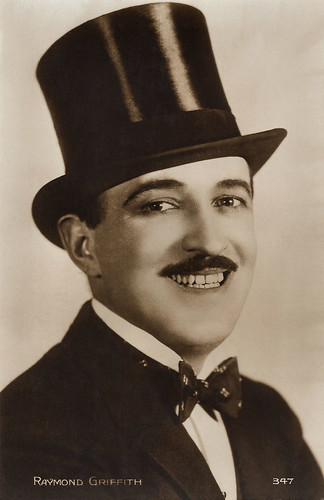
French postcard by Editions Cinémagazine, no. 347.
An acting style uniquely his own
Raymond Griffith was born in Boston, Mass. in 1895. His parents, James Henry Griffith and Mary Guichard, were both actors, as were his grandfather, Gerald Griffith, and his great grandfather, Thomas Griffith. When he was 15 months old, Raymond made his stage debut and by the age of seven he played the lead in 'Little Lord Fauntleroy.'
He lost his voice at an early age, causing him to speak for the rest of his life in a hoarse whisper. Griffith claimed that it was the result of his having to scream at the top of his lungs every night in the stage melodrama 'The Witching Hour' as a child actor. Others have stated that a respiratory diphtheria had permanently damaged his vocal chords.
Afterwards, he worked in a circus, was a dancer and dance teacher, toured Europe with French pantomime players and joined the US Navy for a while, before settling in California in 1914.
In 1915, he made his film debut at the L-KO Kompany, where a played in countless comedies. In 1916, he switched to Mack Sennett's Keystone in 1916, where he remained for years. At first Griffith worked mostly as gagman and scriptwriter. After interludes at Fox and Triangle, Griffith returned to Keystone in 1918.
From 1918 he worked mainly in features. In 1921 he joined director Marshall Neilan's unit. While with Neilan, he returned to acting and, it is assumed, continued writing scenarios. In the fall of 1922, he left Neilan and got a contract at Goldwyn Pictures, which eventually would merge into MGM.
Griffith's first film for his new studio was the mystery-melodrama Red Lights (Clarence G. Badger, 1923) with Marie Prevost . He appeared in Tod Browning's The Day of Faith (1923) with Eleanor Boardman and Tyrone Power, Sr.
It was here that his career as star comedian began. In his 1991 article 'Another Griffith', Davide Turconi notes in Griffithiana: "As for Griffith's Goldwyn period, however, it is worth mentioning that he introduced certain changes to the films in which he appeared between 1922 and 1923 that clearly reflect his earlier experience with Lehrman (L-KO) and Sennett."
Jon Hopwood adds at IMDb : "During his Goldwyn period, Griffith created an acting style uniquely his own that was a hybrid of the comedic and the dramatic. In his Goldwyn films he played detectives & journalists and characters not entirely on the side of the law. His characters were not explicitly comic, but the characterisations were infused with Griffith's panache, spiced with comic business that occasionally crossed the threshold into slapstick. The style often tipped the scenarios over into farce. "
At MGM, he also played in dark tales such as The White Tiger (Tod Browning, 1923) starring Priscilla Dean , in which he is searching for the murderer of his father (Wallace Beery).
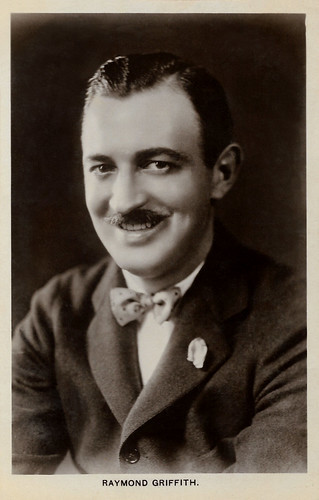
British postcard in the Picturegoer Series, London, no. 327.
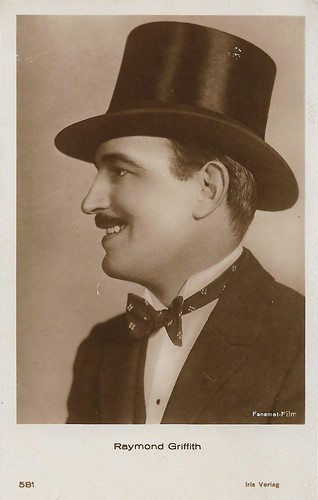
Austrian postcard by Iris Verlag, no. 581. Photo: Fanamet-Film.
The work of an inventive, unaggressive, amiably iconoclastic intelligence
In late 1923 or early 1924, Raymond Griffith signed a contract with Famous Players, where he made five pictures. The first was Changing Husbands (1924) directed by Cecil B. DeMille and co-starring Leatrice Joy.
Then he moved to Paramount where some of his best films were made, first of all Paths to Paradise (Clarence Badger, 1925) with Betty Compson, a caper film that is in all circulating prints missing its final reel. It was highly praised when it came out and a critic predicted that he would become Chaplin's top rival.
Even more famous is Hands Up! (1926), a Civil War comedy feature directed by Clarence G. Badger, and co-starring Mack Swain, which was entered into the National Film Registry in 2005. Sennett plays Jack, a spy for the Confederate States of America, who tries to capture a Union shipment of gold. Obstacles along the way include a pair of sisters, hostile Indians, and a firing squad. In his 1975 book 'The Silent Clowns', Walter Kerr wrote about it: "Hands Up! contains some work that is daring - for its period, certainly - and some that is masterfully delicate, the work of an inventive, unaggressive, amiably iconoclastic intelligence."
His next film, Wet Paint (Arthur Rosson, 1926) with Helene Costello and Bryant Washburn, brought him more high praise from the critics. Griffith made one more film in 1926 and two in 1927. Although 1926 brought him kudos from the critics, neither of the 1927 films received positive reviews, and, according to at least one fan magazine of the time, Griffith and Famous Players brought his contract to an end by "mutual consent."
Like many silent comedians, Griffith had a traditional costume; his was a top hat, white tie and tails, often augmented by a cape and/or walking stick. Unfortunately, many of Griffith's starring feature films have long since been lost, or have not been re-released.
The coming of sound ended Griffith's acting career, but he did have one memorable film role before retiring from the screen, In the classic anti-war film All Quiet on the Western Front (Lewis Milestone, 1930) he plays the French soldier who takes cover in the same shell crater as German soldier Lew Ayres, who stabs him with a bayonet and is then forced to spend the night watching him die.
It was a small but pivotal role. Jon C. Hopwood: " Because of his wounds, the French soldier cannot speak above a whisper, which enabled Griffith to play the role. The scene, in which the French soldier slowly dies, is made harrowing and haunting by Griffith's performance."
Griffith then retired from acting, but not from the cinema. He continued to work at Twentieth Century Fox as a production supervisor and associate producer.
In 1957, Raymond Griffith choked to death at the Masquers Club in Los Angeles, California, aged 62. His asphyxia was due to partially masticated food. Griffith was married to stage and film actress Bertha Mann between 1928 and his death. They had one adopted daughter and two children of their own (one was stillborn).
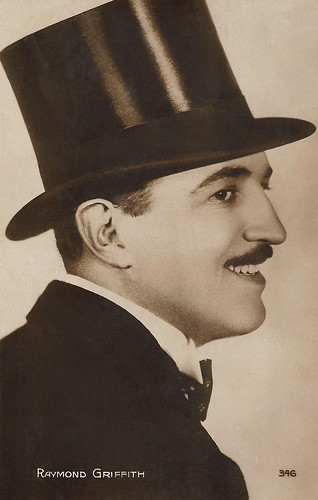
French postcard by Editions Cinémagazine, no. 346.
Sources: (IMDb), Tim Lussier (Silents are Golden), Wikipedia (English and German; actually, the German version gives much more information) and .

French postcard by Editions Cinémagazine, no. 347.
An acting style uniquely his own
Raymond Griffith was born in Boston, Mass. in 1895. His parents, James Henry Griffith and Mary Guichard, were both actors, as were his grandfather, Gerald Griffith, and his great grandfather, Thomas Griffith. When he was 15 months old, Raymond made his stage debut and by the age of seven he played the lead in 'Little Lord Fauntleroy.'
He lost his voice at an early age, causing him to speak for the rest of his life in a hoarse whisper. Griffith claimed that it was the result of his having to scream at the top of his lungs every night in the stage melodrama 'The Witching Hour' as a child actor. Others have stated that a respiratory diphtheria had permanently damaged his vocal chords.
Afterwards, he worked in a circus, was a dancer and dance teacher, toured Europe with French pantomime players and joined the US Navy for a while, before settling in California in 1914.
In 1915, he made his film debut at the L-KO Kompany, where a played in countless comedies. In 1916, he switched to Mack Sennett's Keystone in 1916, where he remained for years. At first Griffith worked mostly as gagman and scriptwriter. After interludes at Fox and Triangle, Griffith returned to Keystone in 1918.
From 1918 he worked mainly in features. In 1921 he joined director Marshall Neilan's unit. While with Neilan, he returned to acting and, it is assumed, continued writing scenarios. In the fall of 1922, he left Neilan and got a contract at Goldwyn Pictures, which eventually would merge into MGM.
Griffith's first film for his new studio was the mystery-melodrama Red Lights (Clarence G. Badger, 1923) with Marie Prevost . He appeared in Tod Browning's The Day of Faith (1923) with Eleanor Boardman and Tyrone Power, Sr.
It was here that his career as star comedian began. In his 1991 article 'Another Griffith', Davide Turconi notes in Griffithiana: "As for Griffith's Goldwyn period, however, it is worth mentioning that he introduced certain changes to the films in which he appeared between 1922 and 1923 that clearly reflect his earlier experience with Lehrman (L-KO) and Sennett."
Jon Hopwood adds at IMDb : "During his Goldwyn period, Griffith created an acting style uniquely his own that was a hybrid of the comedic and the dramatic. In his Goldwyn films he played detectives & journalists and characters not entirely on the side of the law. His characters were not explicitly comic, but the characterisations were infused with Griffith's panache, spiced with comic business that occasionally crossed the threshold into slapstick. The style often tipped the scenarios over into farce. "
At MGM, he also played in dark tales such as The White Tiger (Tod Browning, 1923) starring Priscilla Dean , in which he is searching for the murderer of his father (Wallace Beery).

British postcard in the Picturegoer Series, London, no. 327.

Austrian postcard by Iris Verlag, no. 581. Photo: Fanamet-Film.
The work of an inventive, unaggressive, amiably iconoclastic intelligence
In late 1923 or early 1924, Raymond Griffith signed a contract with Famous Players, where he made five pictures. The first was Changing Husbands (1924) directed by Cecil B. DeMille and co-starring Leatrice Joy.
Then he moved to Paramount where some of his best films were made, first of all Paths to Paradise (Clarence Badger, 1925) with Betty Compson, a caper film that is in all circulating prints missing its final reel. It was highly praised when it came out and a critic predicted that he would become Chaplin's top rival.
Even more famous is Hands Up! (1926), a Civil War comedy feature directed by Clarence G. Badger, and co-starring Mack Swain, which was entered into the National Film Registry in 2005. Sennett plays Jack, a spy for the Confederate States of America, who tries to capture a Union shipment of gold. Obstacles along the way include a pair of sisters, hostile Indians, and a firing squad. In his 1975 book 'The Silent Clowns', Walter Kerr wrote about it: "Hands Up! contains some work that is daring - for its period, certainly - and some that is masterfully delicate, the work of an inventive, unaggressive, amiably iconoclastic intelligence."
His next film, Wet Paint (Arthur Rosson, 1926) with Helene Costello and Bryant Washburn, brought him more high praise from the critics. Griffith made one more film in 1926 and two in 1927. Although 1926 brought him kudos from the critics, neither of the 1927 films received positive reviews, and, according to at least one fan magazine of the time, Griffith and Famous Players brought his contract to an end by "mutual consent."
Like many silent comedians, Griffith had a traditional costume; his was a top hat, white tie and tails, often augmented by a cape and/or walking stick. Unfortunately, many of Griffith's starring feature films have long since been lost, or have not been re-released.
The coming of sound ended Griffith's acting career, but he did have one memorable film role before retiring from the screen, In the classic anti-war film All Quiet on the Western Front (Lewis Milestone, 1930) he plays the French soldier who takes cover in the same shell crater as German soldier Lew Ayres, who stabs him with a bayonet and is then forced to spend the night watching him die.
It was a small but pivotal role. Jon C. Hopwood: " Because of his wounds, the French soldier cannot speak above a whisper, which enabled Griffith to play the role. The scene, in which the French soldier slowly dies, is made harrowing and haunting by Griffith's performance."
Griffith then retired from acting, but not from the cinema. He continued to work at Twentieth Century Fox as a production supervisor and associate producer.
In 1957, Raymond Griffith choked to death at the Masquers Club in Los Angeles, California, aged 62. His asphyxia was due to partially masticated food. Griffith was married to stage and film actress Bertha Mann between 1928 and his death. They had one adopted daughter and two children of their own (one was stillborn).

French postcard by Editions Cinémagazine, no. 346.
Sources: (IMDb), Tim Lussier (Silents are Golden), Wikipedia (English and German; actually, the German version gives much more information) and .
Published on November 13, 2019 22:00
Paul van Yperen's Blog
- Paul van Yperen's profile
- 13 followers
Paul van Yperen isn't a Goodreads Author
(yet),
but they
do have a blog,
so here are some recent posts imported from
their feed.



